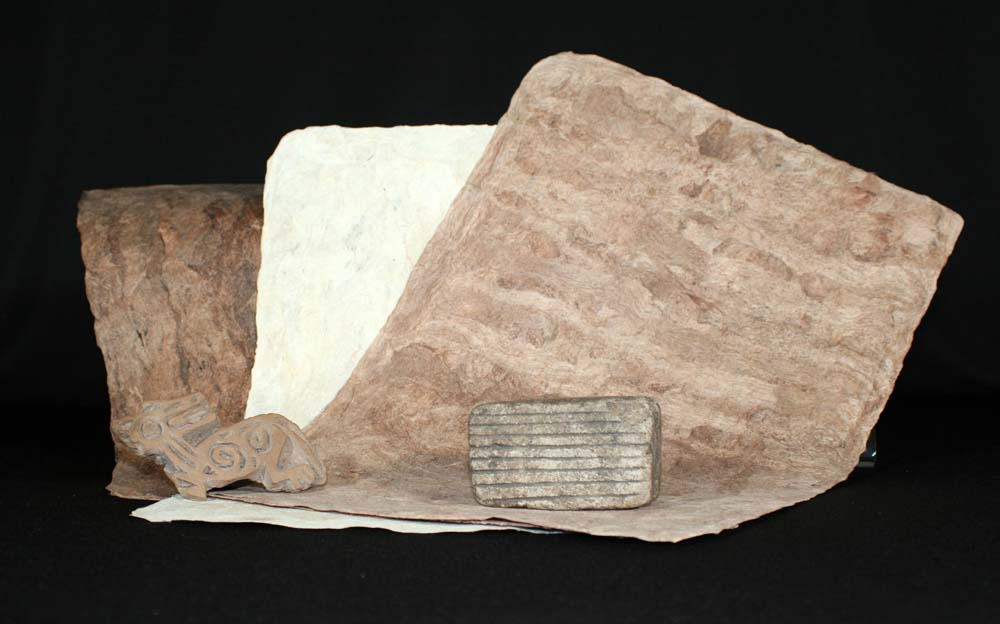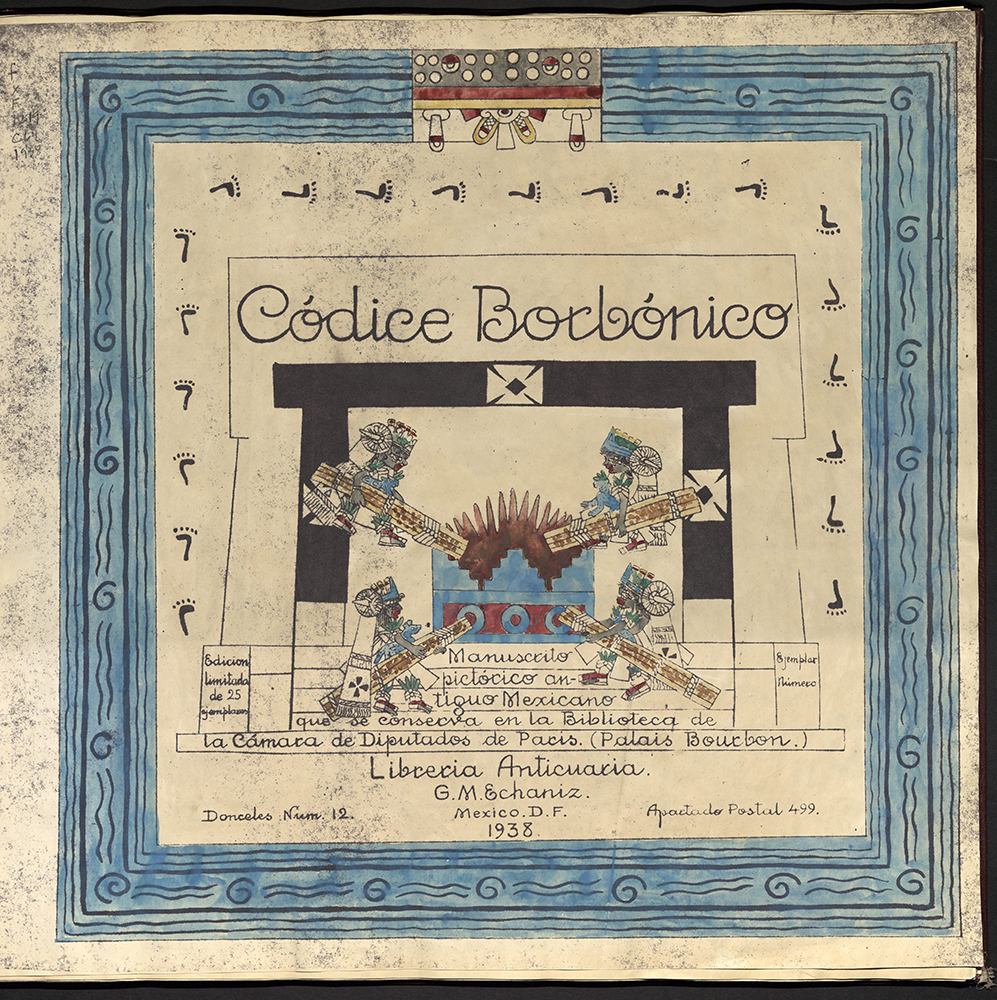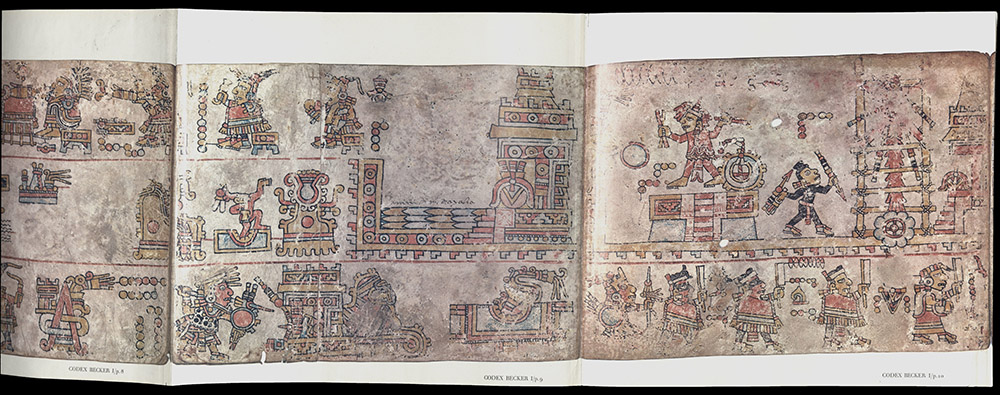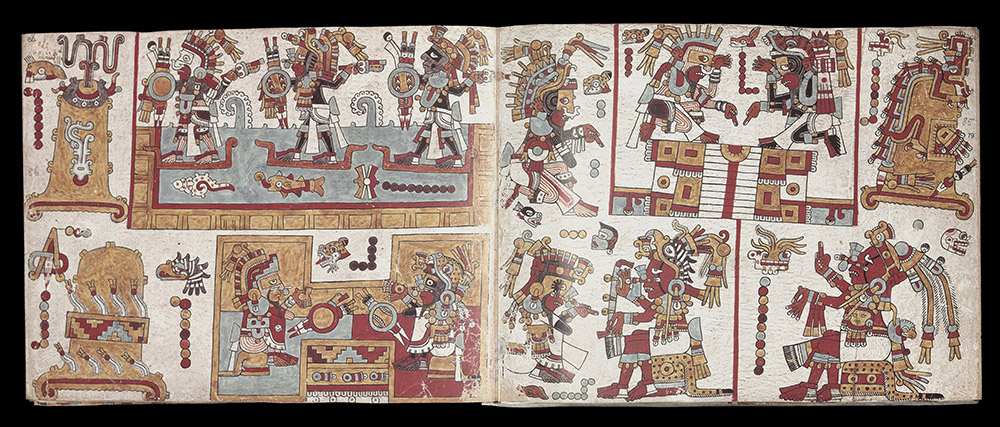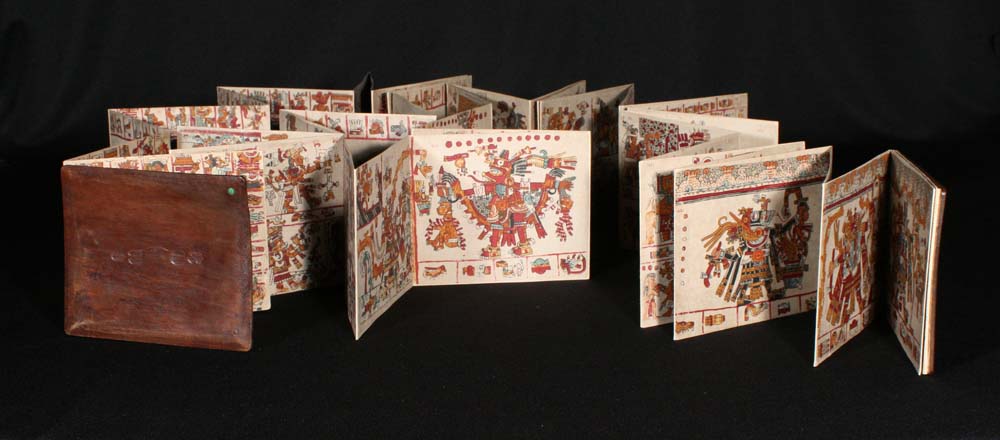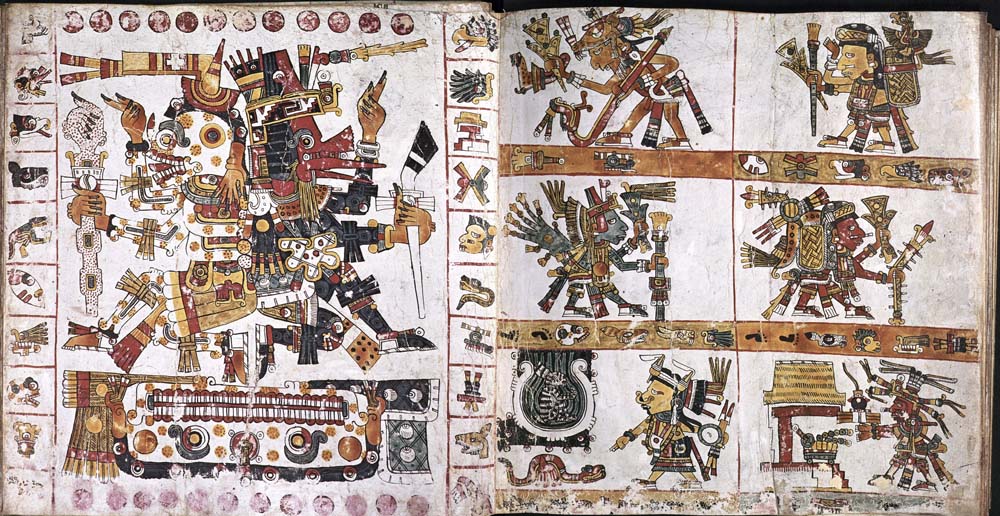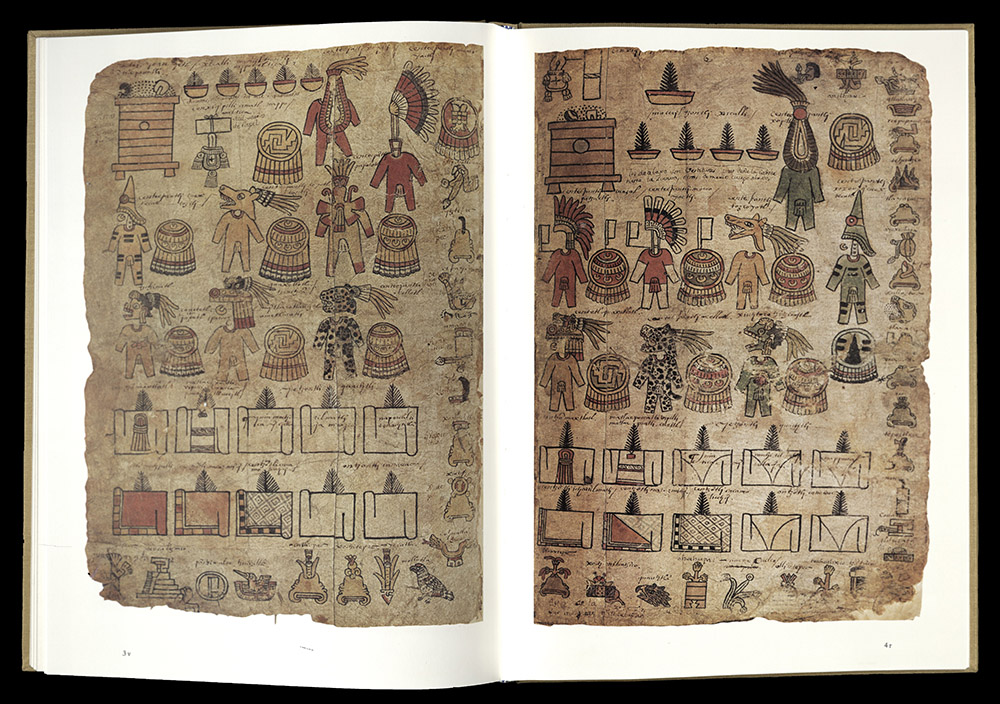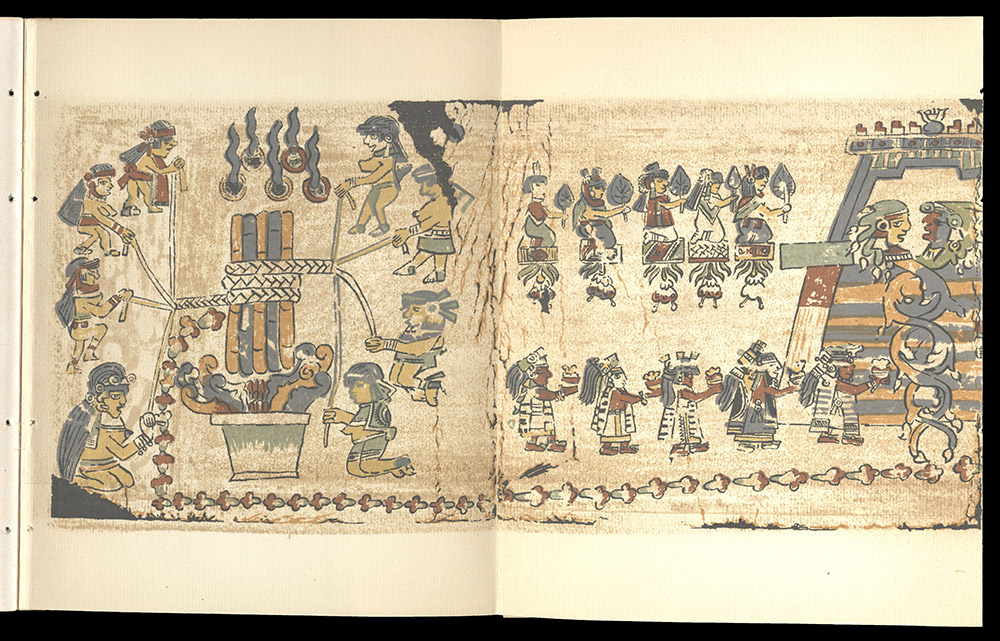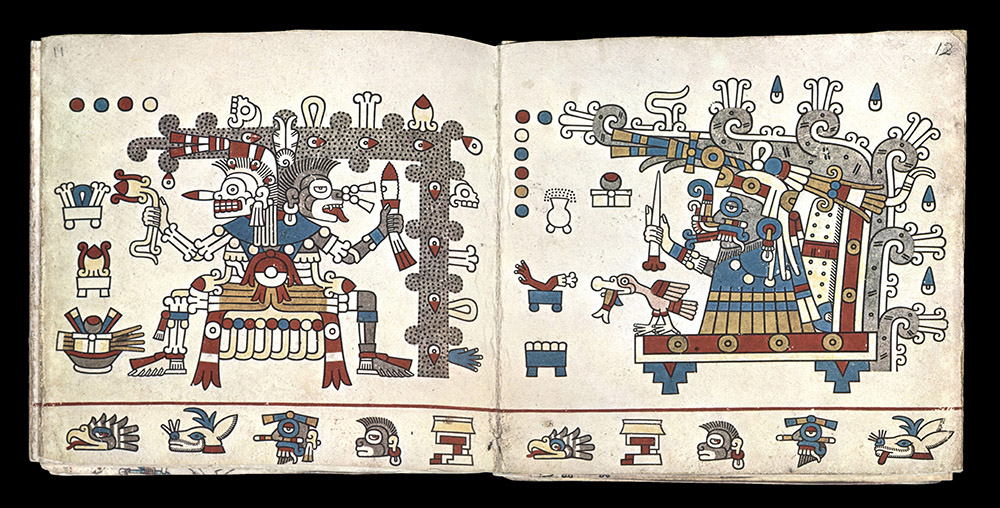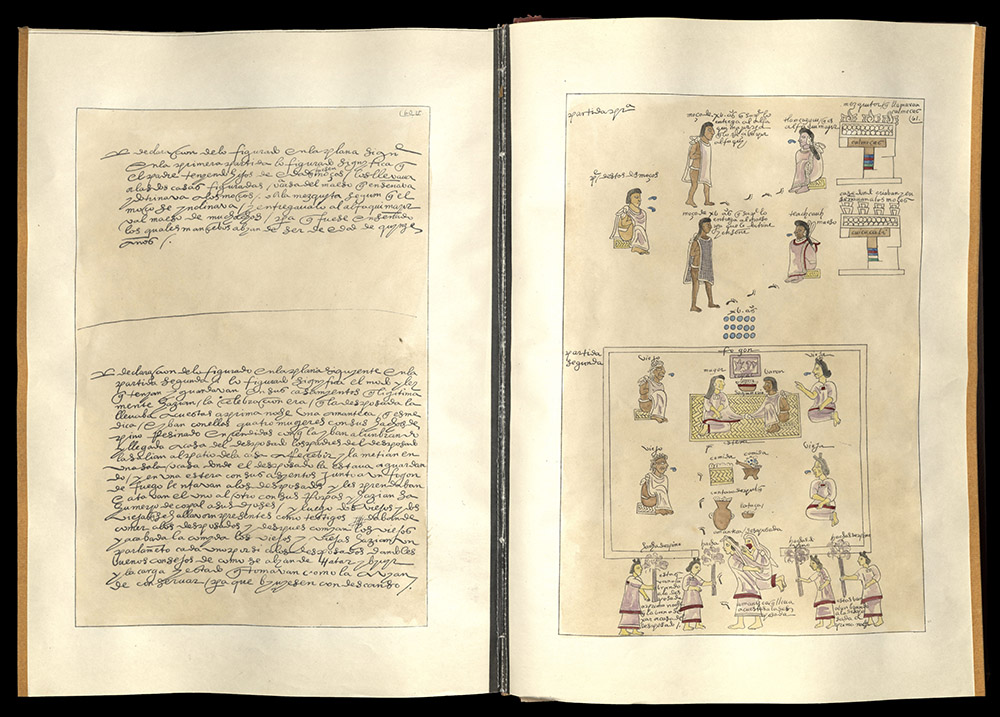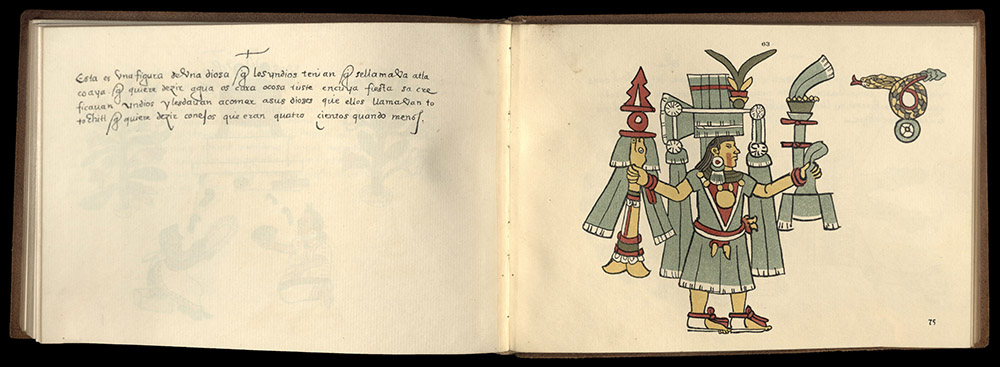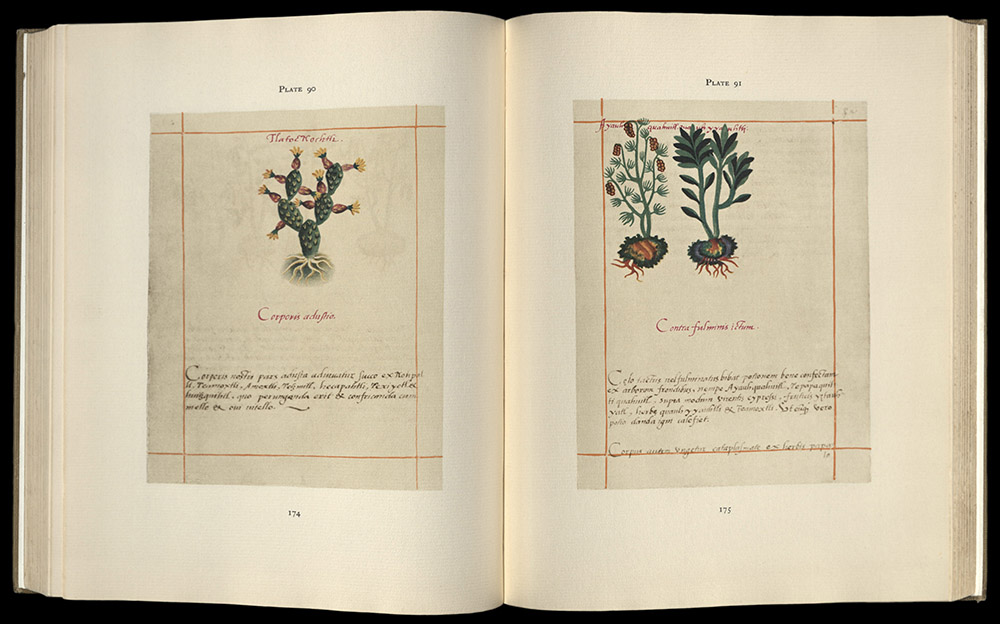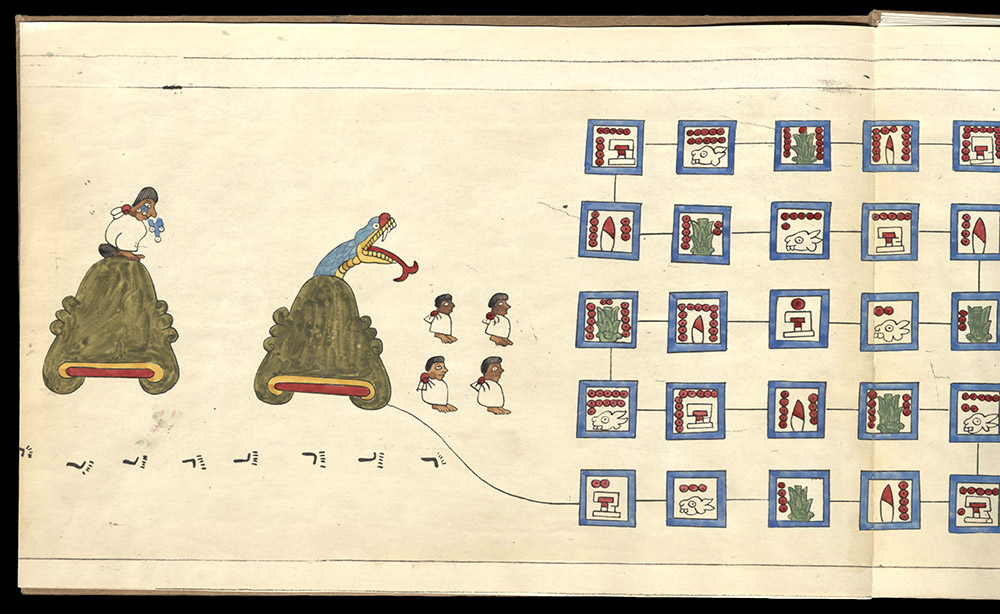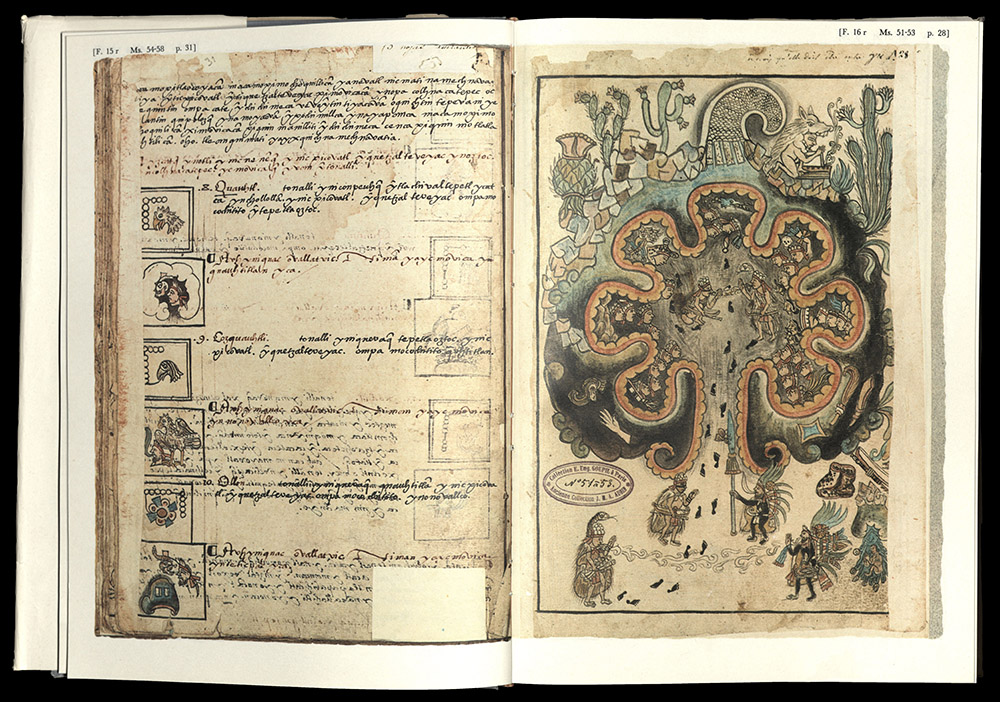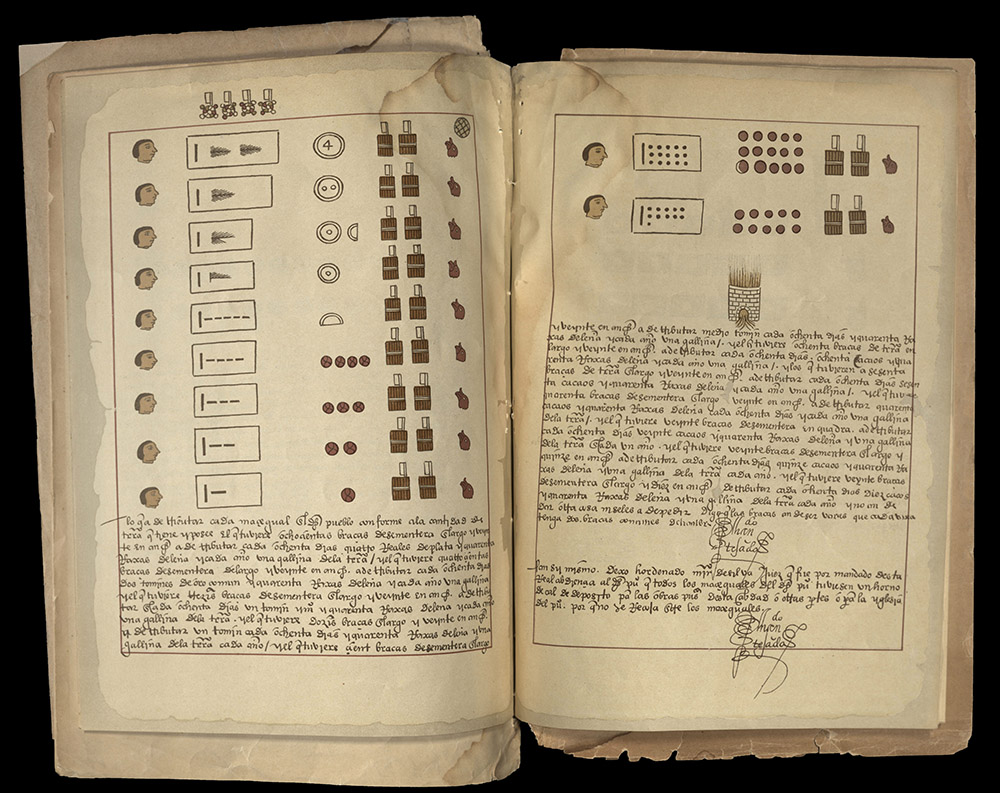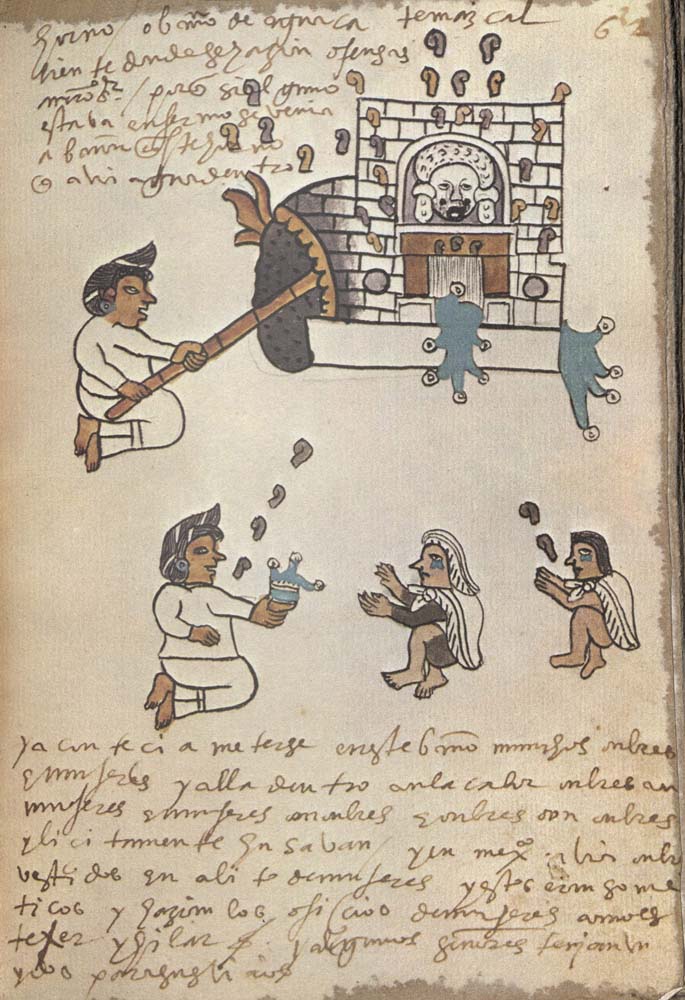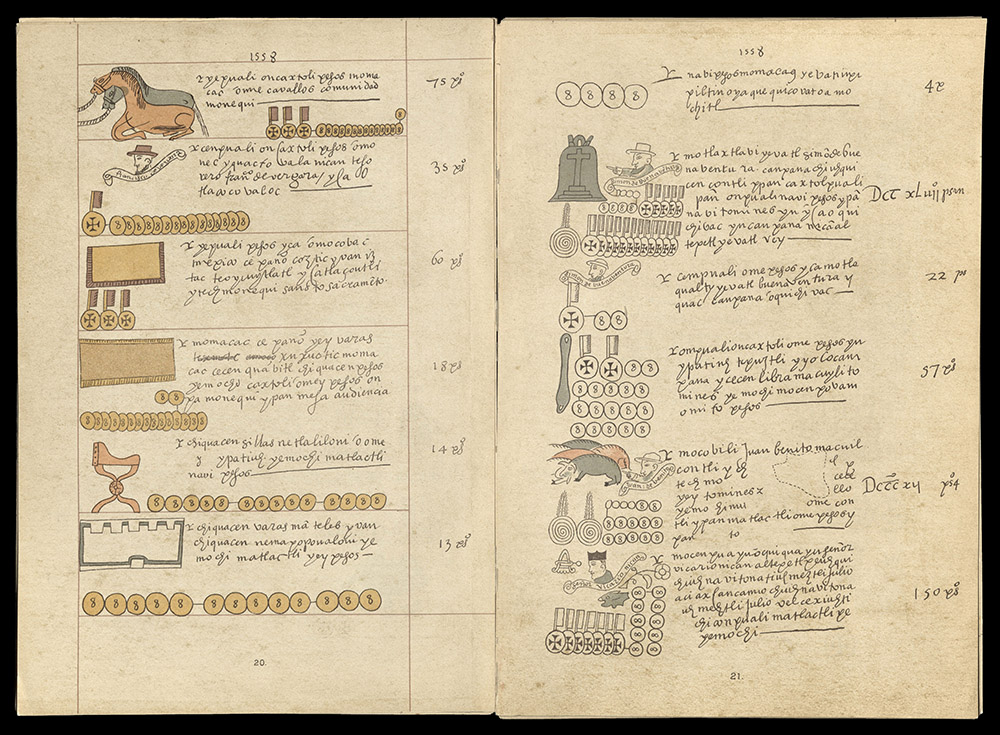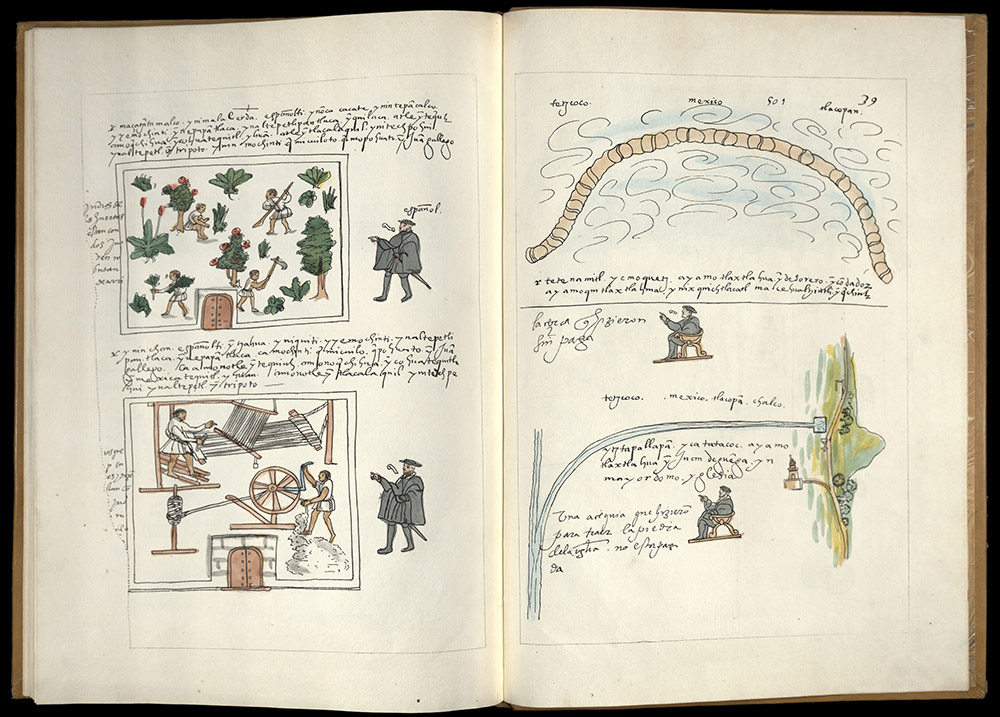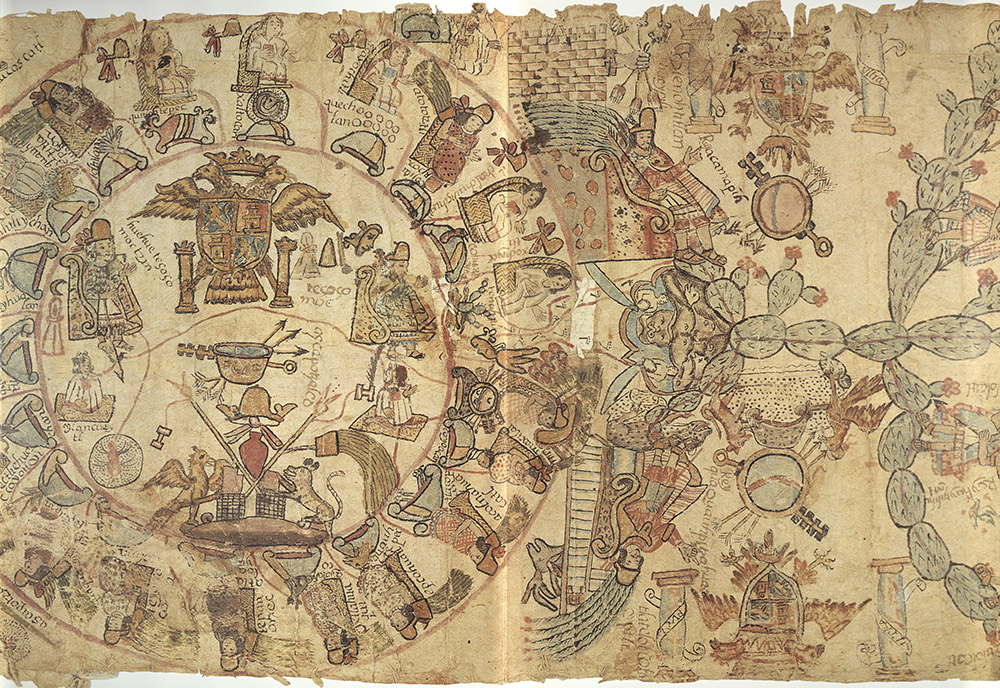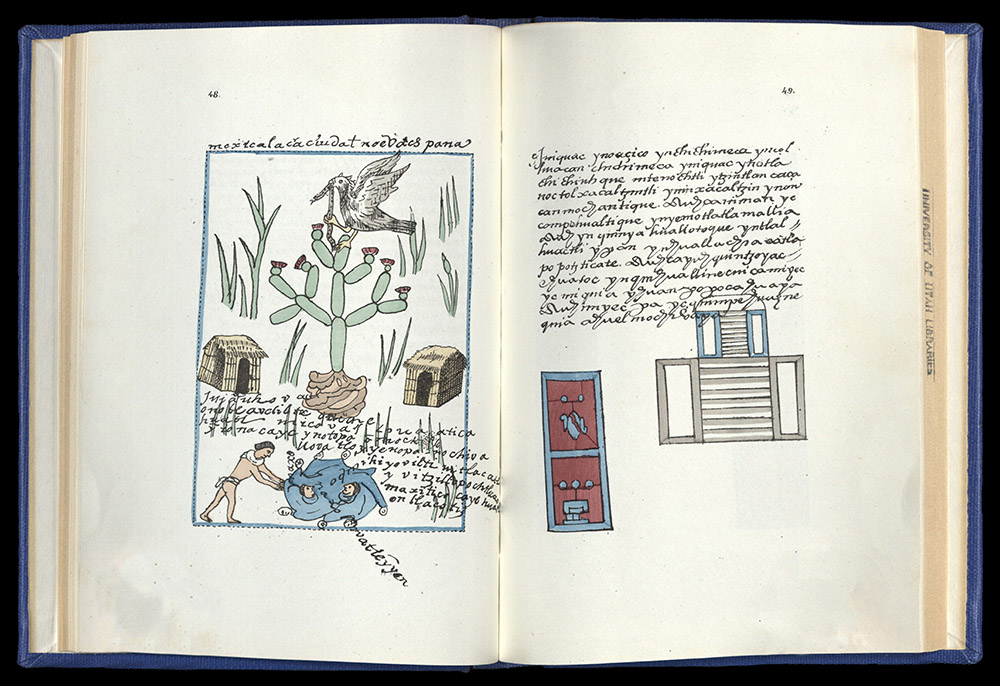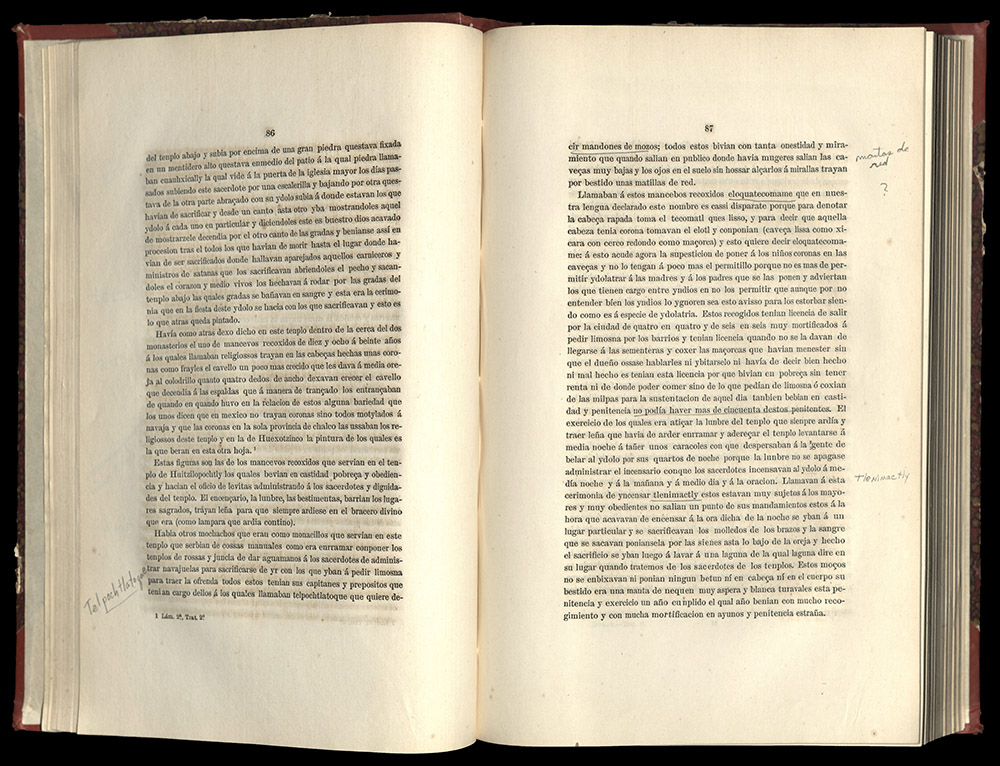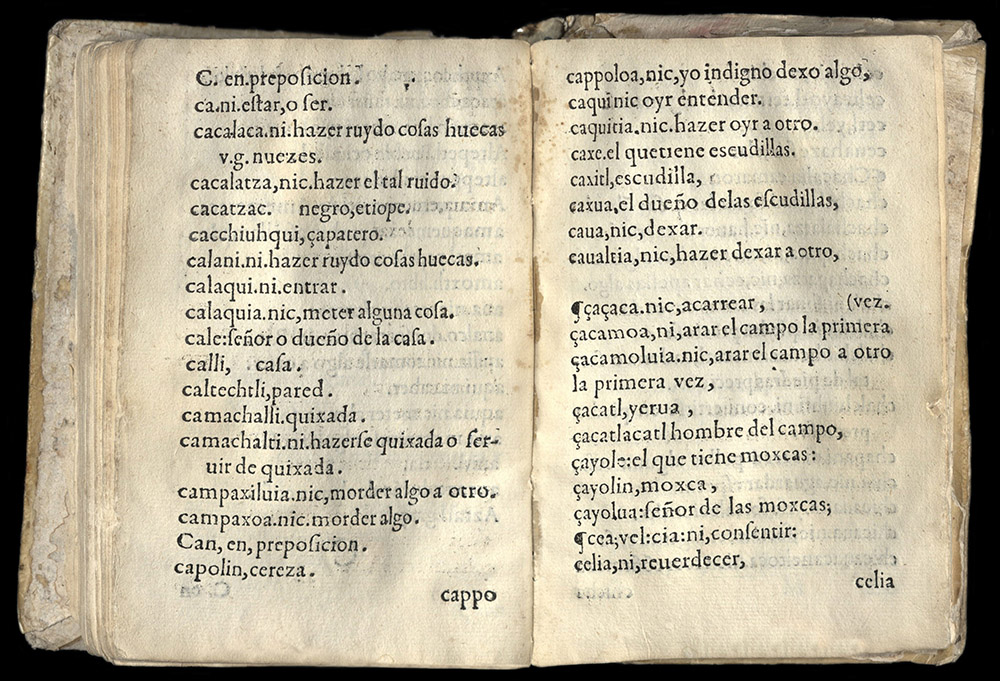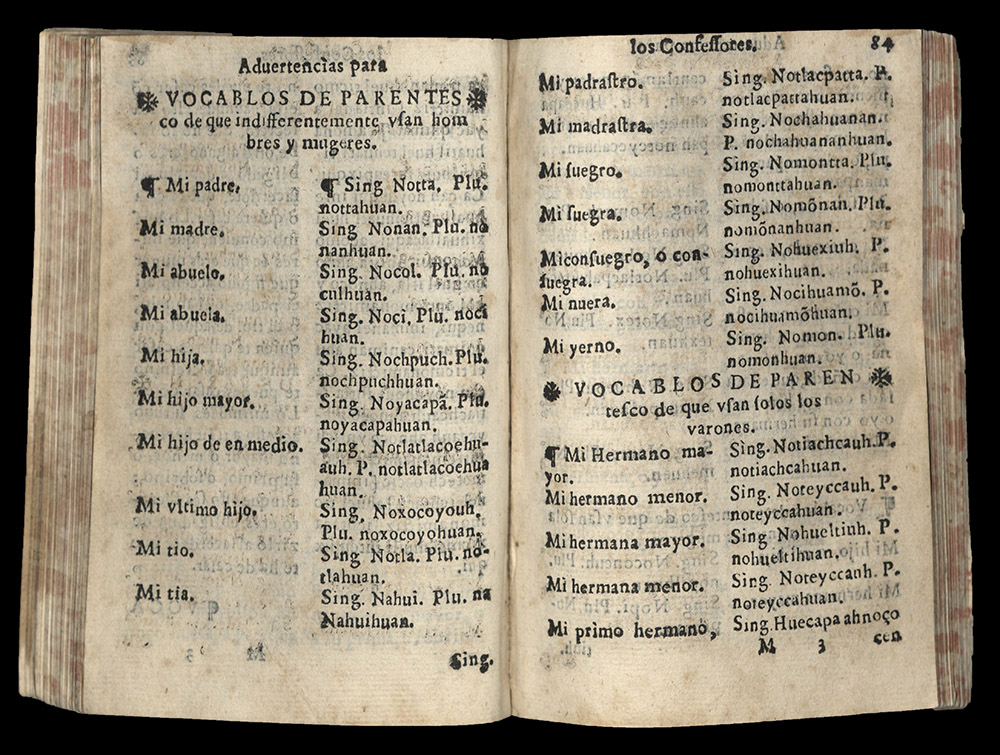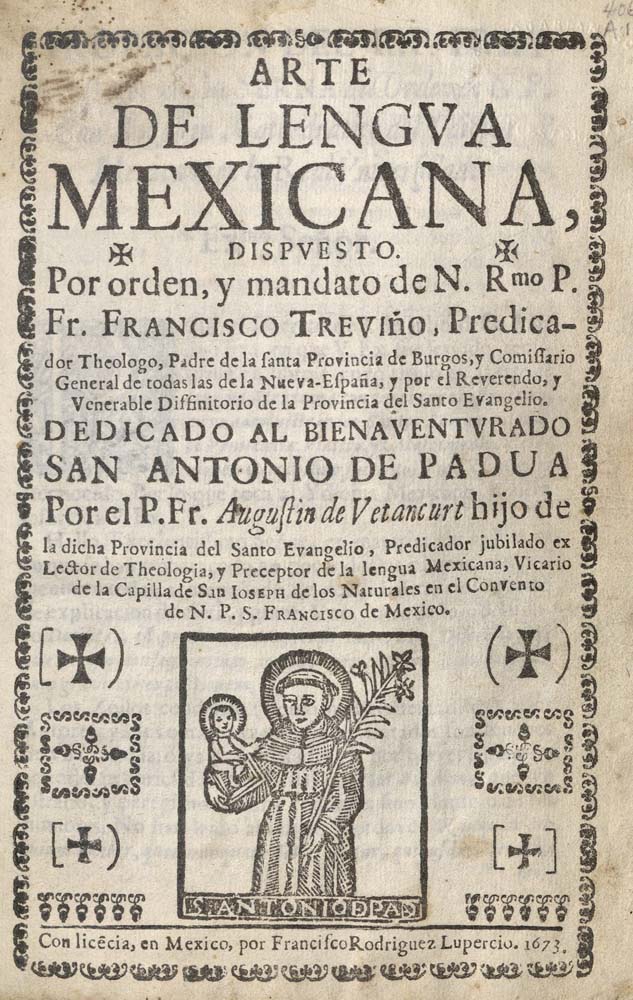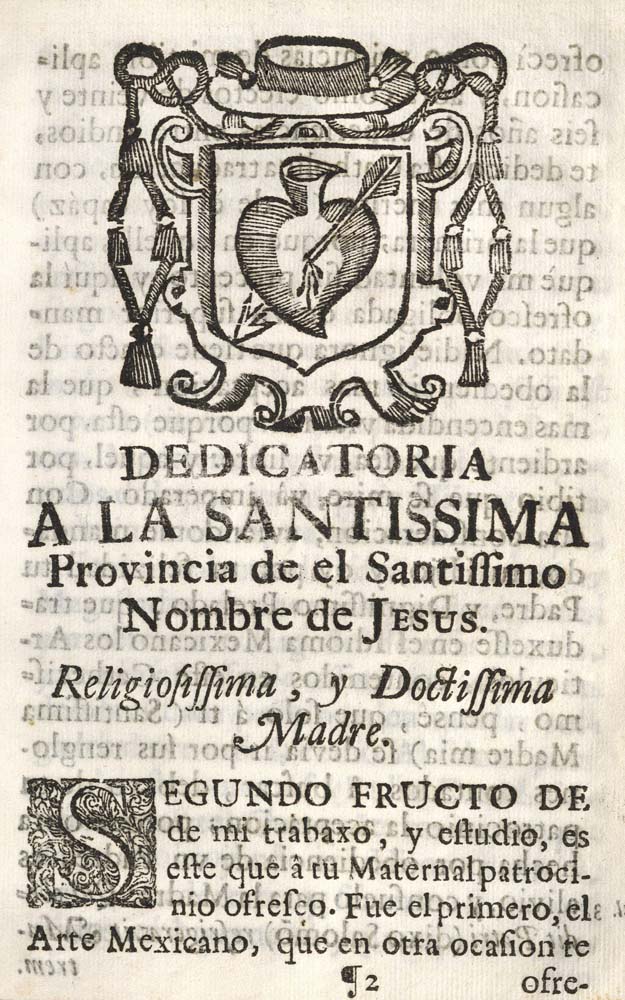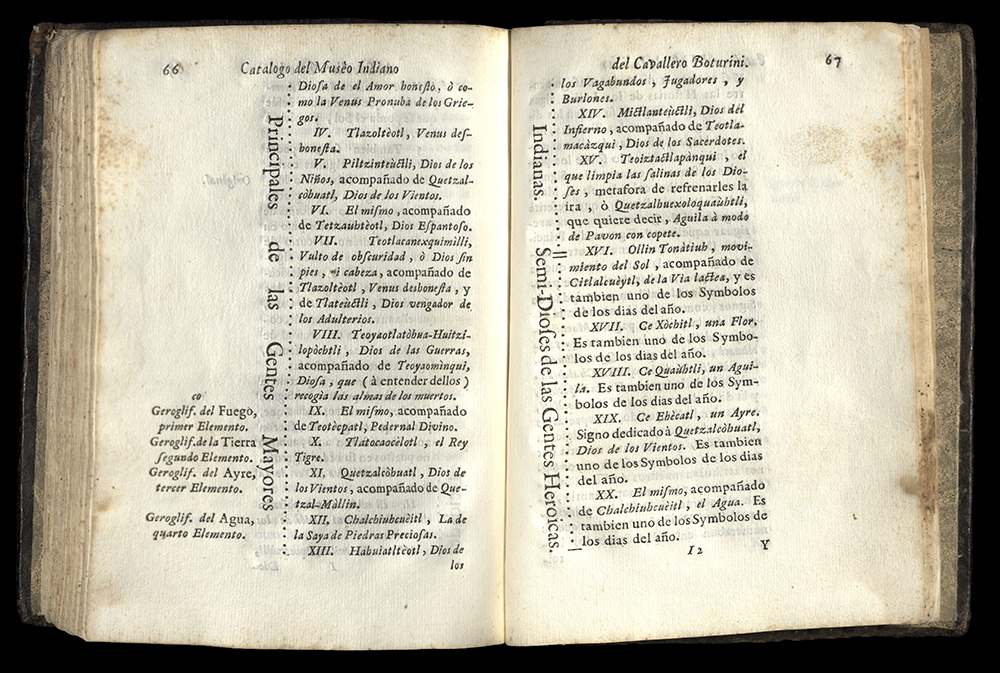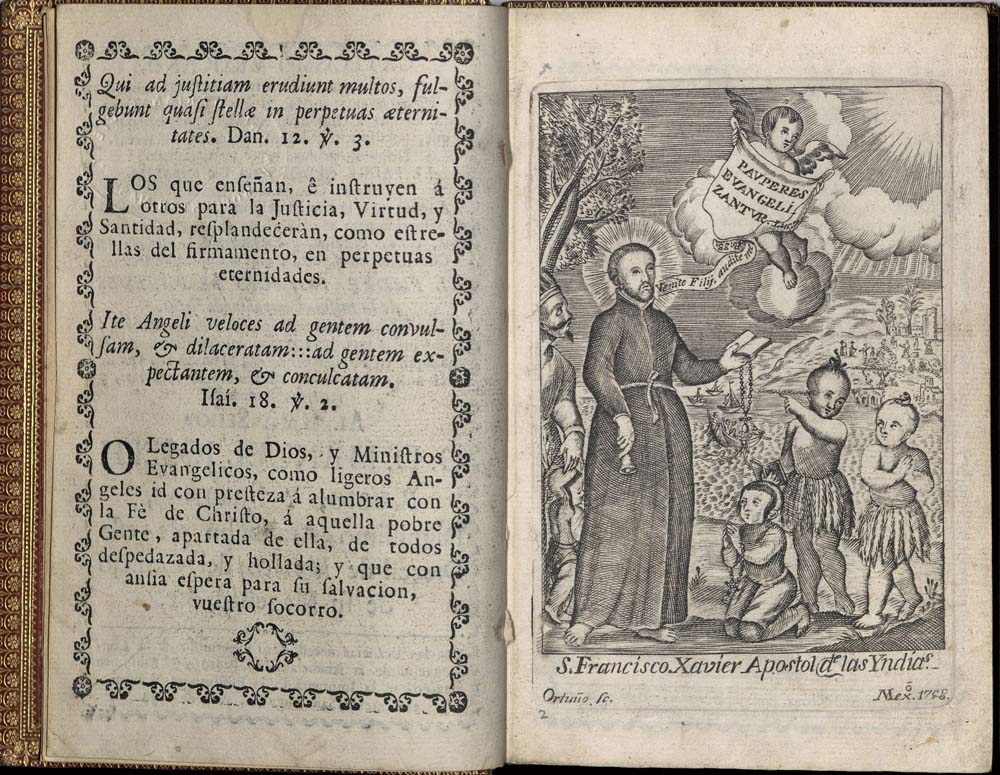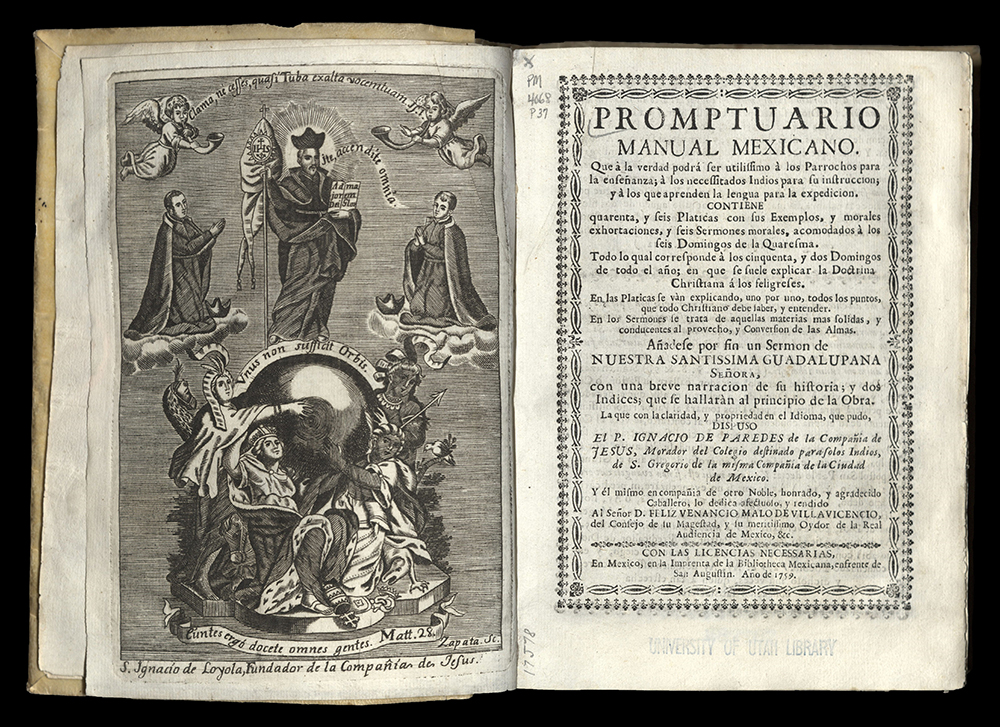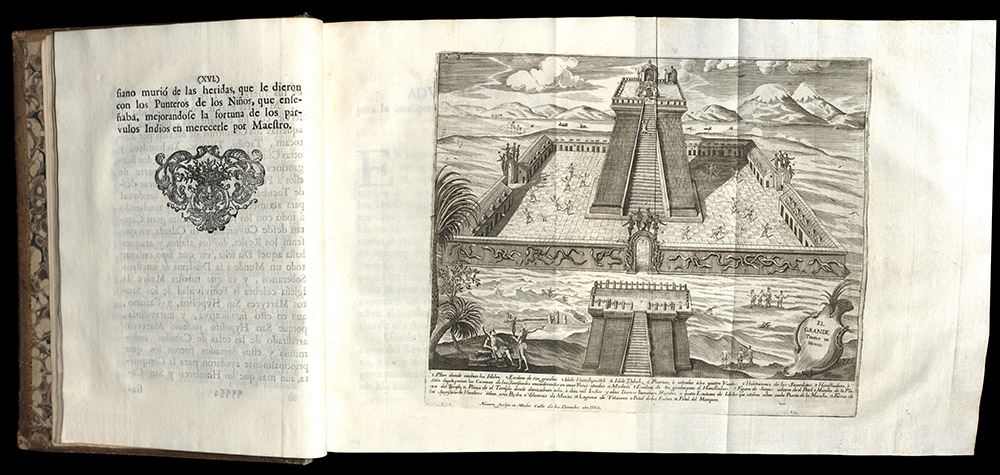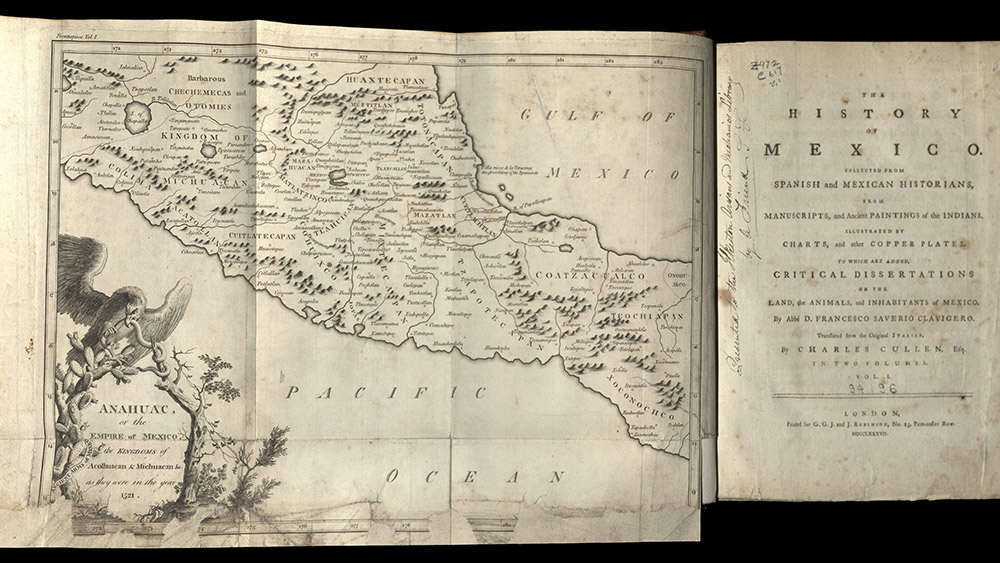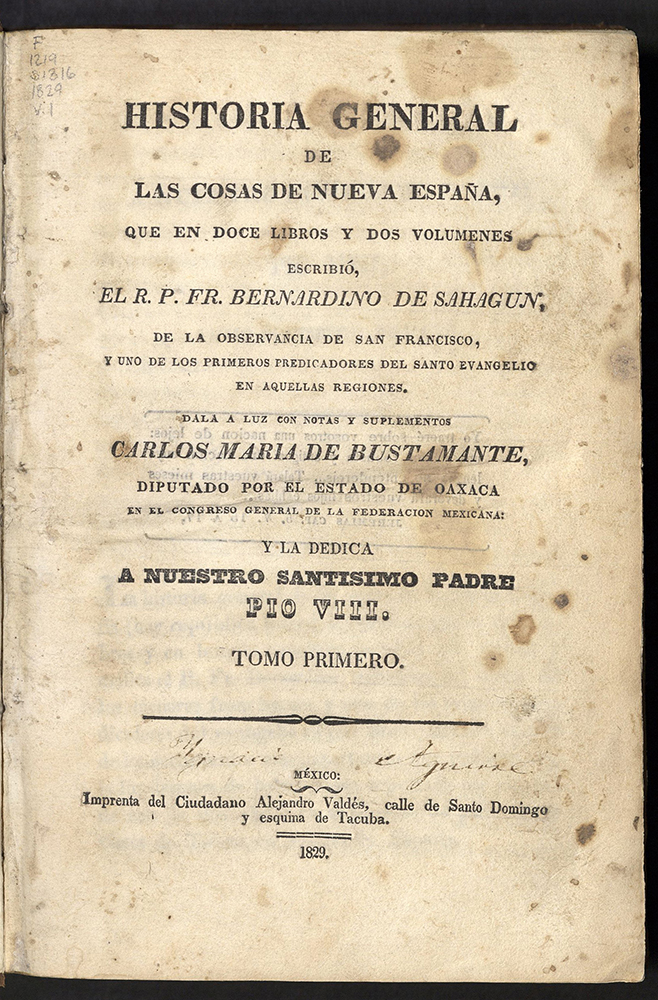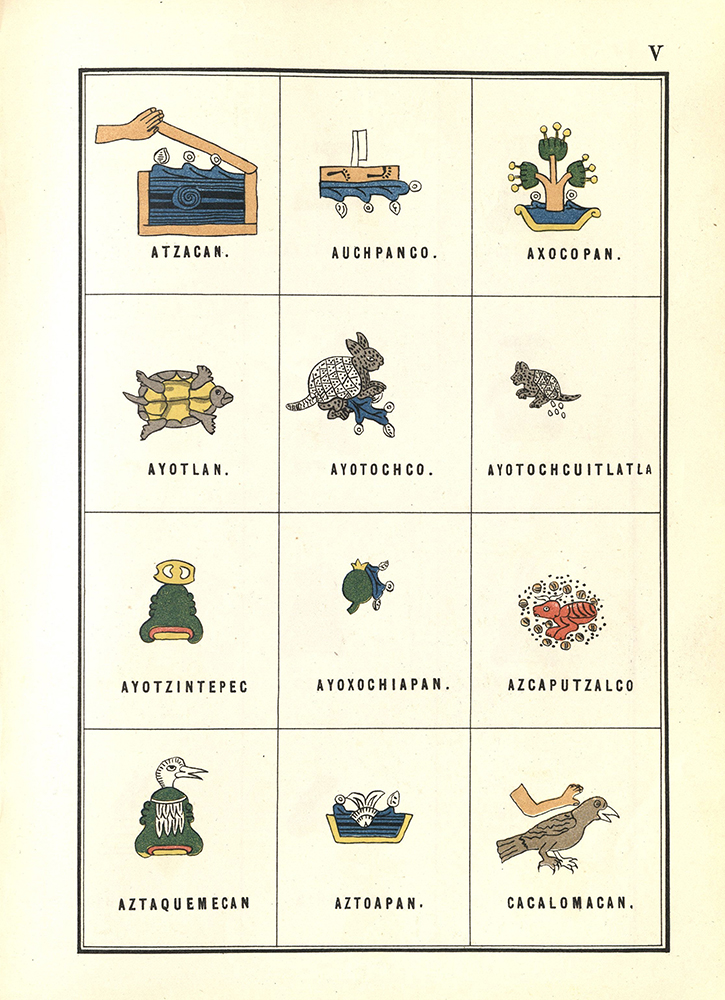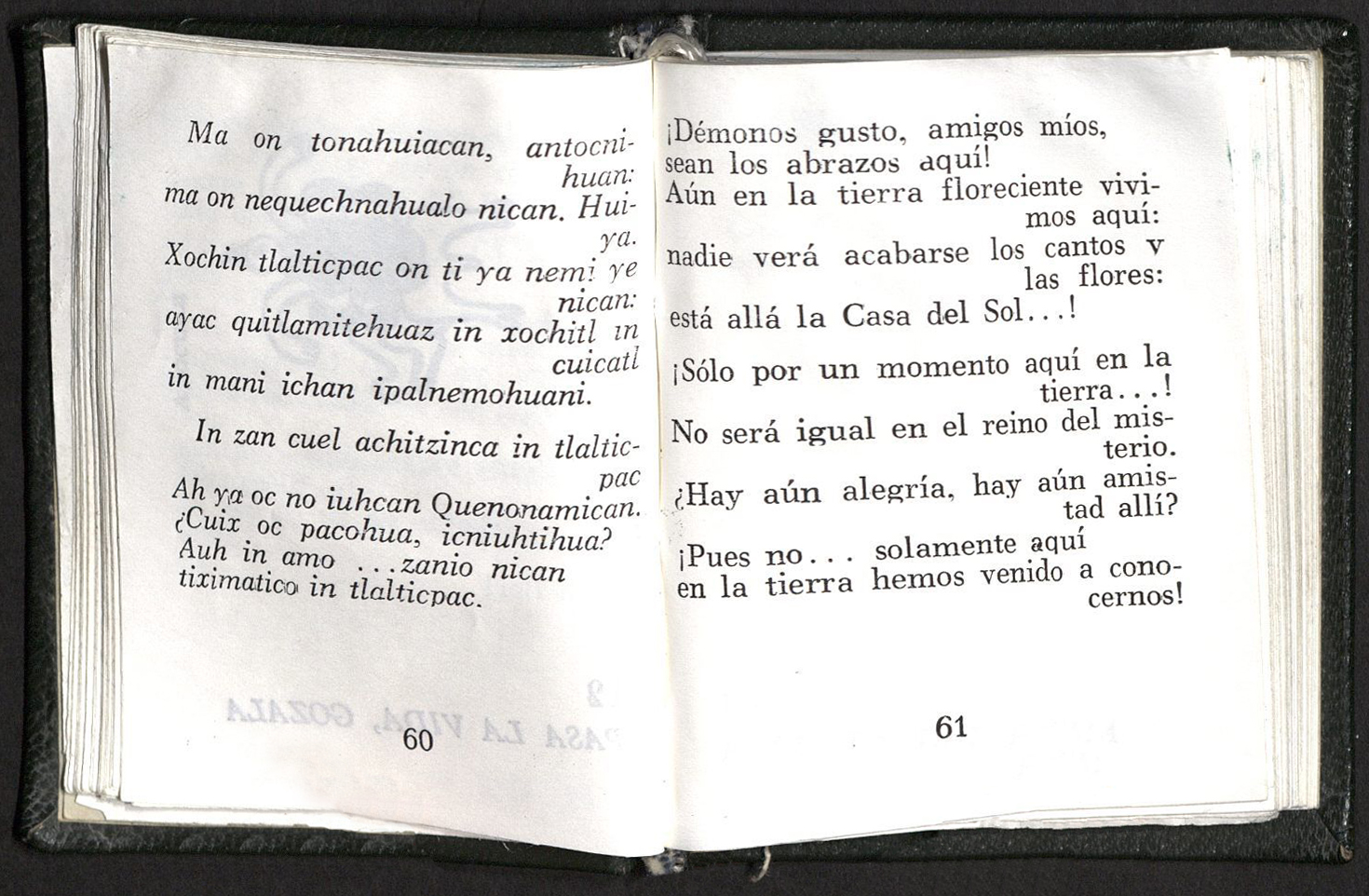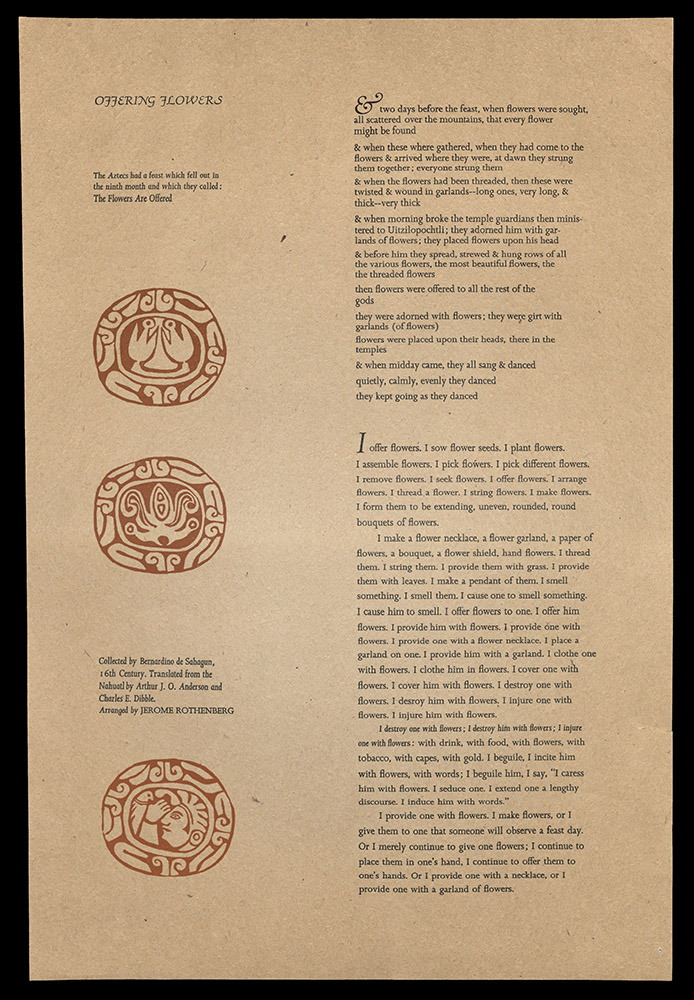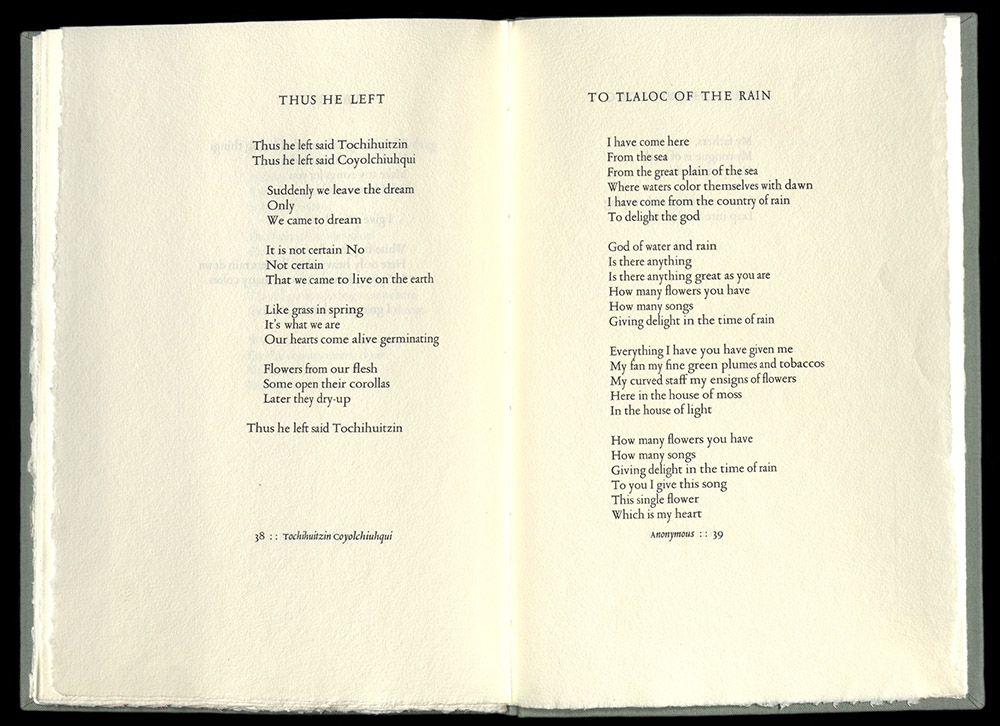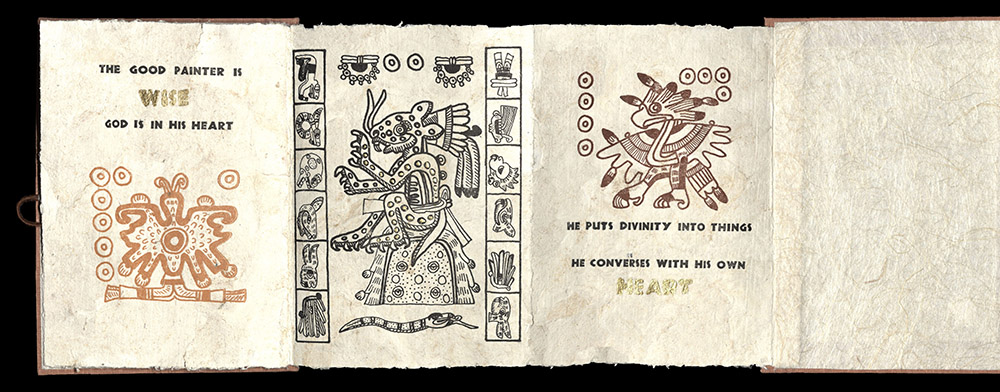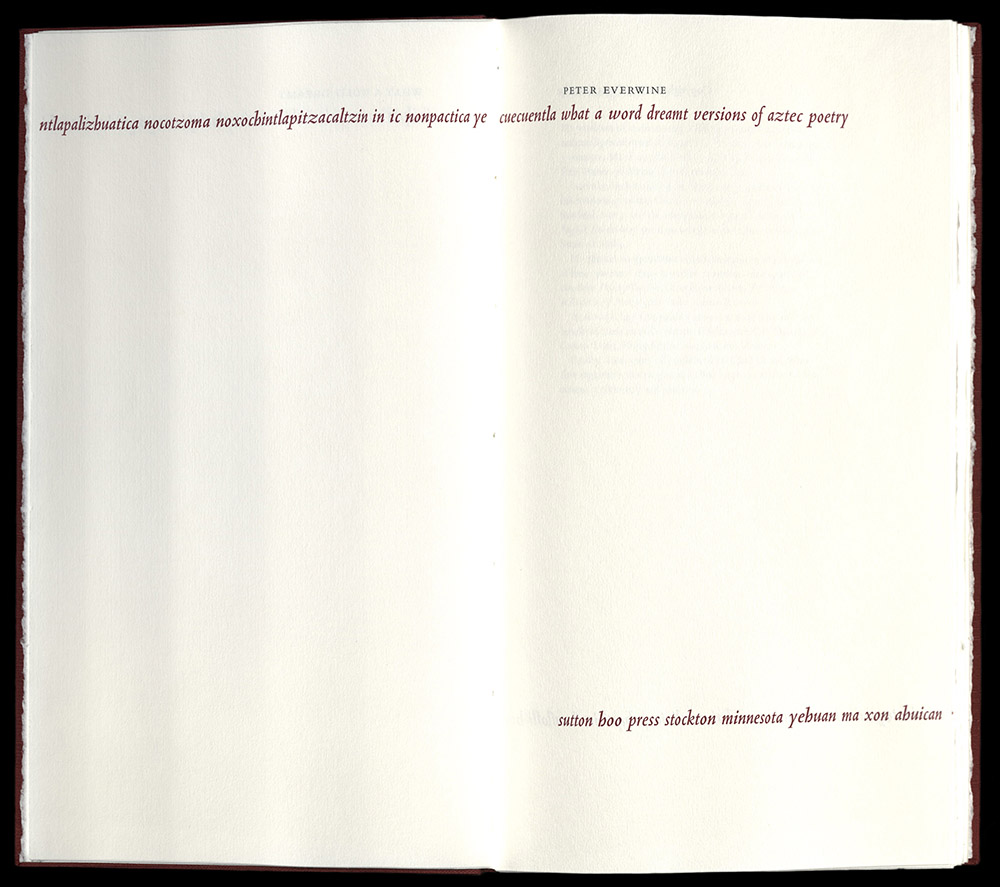Nahuatl Spoken Here
Curated by Luise Poulton, 2013
Exhibition poster designed by David Wolske, 2013
Digital exhibition produced by Alison Elbrader, 2015
Format updated by Lyuba Basin, 2020
![[IMAGE]](/img/rare-books/nahuatlspokenhereposter.jpeg)
Nahuatl was the language of the Aztec and is spoken today by approximately 1.5 million people. In collaboration with the Latin American Studies Program, the Second Language Teaching and Research Center began offering instruction in Nahuatl in fall 2012. The University of Utah is only one of several academic institutions in the United States that teach Nahuatl on a regular basis. The Rare Books Division holds one of the largest collections of Mesoamerican codex facsimiles in the United States, thanks to Prof. Charles Elliott Dibble (1909-2002), one of the world's leading experts on Mesoamerica. Dr. Dibble taught at the University of Utah in the department of Anthropology for four decades. He donated his extensive book collection to the J. Willard Marriott Library. The Rare Books Division continues to build on this legacy. On exhibition are copies of Mesoamerican facsimiles, 16th through 18th century first editions of European/Nahuatl books, and 20th century artists' books inspired by a far-from-forgotten culture.
BARK PAPER
TS1124 I63
Realia. Handmade paper from the fibers of the wild fig tree. The paper was made in the twentieth century using 8th century Mesoamerican techniques.
STONE BARK BEATER
Valley of Teotihuacan, 8th century
TX1124 S76
Realia. A common artifact from the Valley of Teotihuacan, home of the Aztec peoples. The beater was used to manufacture amátl from fibers of the wild fig tree.
CLAY STAMP WITH JAGUAR DESIGN
8th century?
NK9504 C53
Realia. A Mayan artifact used for decorative stamping of fabrics and ceramics, and for printing on huun, or fig bark, paper.
FACSIMILE CODICE BORBONICUS
Mexico: Libraria Anticuaria G. M. Echaniz, 1938
F1219 C64
From the commentary volume: “The Codex Borbonicus…has been in the possession of the… [Palais Bourbon] since 1826…The pages are made up of sheets or strips of paper overlapping and adhering to each other…According to the traditional technique, the paper is made of beaten tree-bark (amaquahuitl)...The manuscript is painted on one face only and reveals the work of at least two artists.” -- Jacqueline de Durand-Forest
“The style of Codex Borbonicus…is the Aztec style of pre-conquest times. A certain impurity of the style suggests that the item is a copy from early colonial times...The contents form a unity, consisting of 1) the 260-day tonalpohualli; 2) the 52 years, connected with the tonalamatl and bearing designations after the days of this cycle; 3) complementing to that of the annual celebrations (of the passing from the first to the second year of the cycle); 4) the continuation (from the third year of the cycle on) until the year of making the new fire, 2 reed... [The first section consists of] the twenty 13-day weeks of the 260-day cycle (tonalpohualli), with respect to divination and ritual. The codex contains two series of gods in different functions, although sometimes the same gods are represented… [The second section consists of] the cycle of fifty-two 365-day years (xiuhmolpilli) with respect to the calendar. Each 26 of the 52 years are assigned to different gods. Assigned to all years are those…who in the tonalpohualli…are in charge for the first day of the year (the year’s bearer)… [The third section consists of] the celebrations of the eighteen 20-day sections (ilhuitl) of the year (and five days) of the 365-day year, with respect to ritual. The functions of the gods in the third section are totally different from those in the first section…For instance, when Chalchiuhtlicue in the tonalpohualli is characterized by the dangerous aspect of water, the torrential flood, she plays in the ritual a totally different part – she and her sisters (Vixtociuatl and Chicomecoatl) are the giver of life, as they represent – or are identical to water, salt and maize. [The fourth section consists of] the 52 year’s xiuhmolpilli with respect to ritual…celebration, izcalli,… This celebration is situated a full year after the last celebration of the third section.” -- Karl Anton Novotny
FACSIMILE CODEX BECKER I/II
Graz: Akademische Druck- u. Verlagsanstalt, 1961
F1219 C639 1961
Two Mexican histories from the Mixtec region in pre-Columbian accordion format. The extant leaves begin the history when Lord Eight Deer is seventeen years old. Other Mixtec codices, such as the Codex Zouche-Nuttall follow similar accounts as the Codex Becker I. From these we know that Lord Eight Dear was born out of his father’s second marriage. He performed several rituals and meetings to become ruler of Tutuepec, then solidified his position through a long series of military campaigns, which ended when he was about twenty-two. Twelve years later, after Lord Four Jaguar conquered the Coixthauhuaca area, Lord Eight Deer’s attempts at diplomatic negotiations were rejected. Calling upon supernatural support, he beat Lord Four Jaguar in a ball game and then consolidated his position. There is evidence of intentional destruction of material in Becker I. Only three fragments of sixteen leaves from the original codex have survived. These include partial genealogies of the dueling Mixtecan dynasties. Codex Becker II contains five leaves which list monarchies and genealogical data, portraying a patriarchal society. Women are depicted following men into homes and other buildings. Descriptions of temple ceremonies place religion in the center of the daily Mixtec life. The original is now housed in the Ethnographical Museum, Vienna.
FACSIMILE ANTIQUITES MEXICAINES
Geneve: Impr. Aubert-Schuchardt, 1891
First edition
F1219 A67 1841
This is a copy of a pre-Columbian manuscript discovered by Henri de Saussure during a tour of Mexico between 1854 and 1856. Saussure copied it secretly, since the owner refused to allow him to copy it. The manuscript was in scroll form and about fifteen feet long. Saussure wrote that he spent five days, from 6am to 11pm copying it, noting that it was exhausting work. He traced the parchment onto fine paper, printed the tracing and then hand-painted the printed copy.
FACSIMILE IL MANOSCRITTO MESSICANO
Rome: stab. Danesi, 1896
F1219 V35
The original 14th century Nahua manuscript resides in the Vatican Library, where it has been since the sixteenth century. The codex is a continuous strip, made up of ten attached sheets of deer skin, covered on both sides with stucco. It was arranged as a screen-fold with a wooden cover at either end. The original covers show traces of ornamental turquoise designs, but only a single piece of the gemstone remains. Although the page size is small, the whole document is one of the most extensive of Mesoamerican manuscripts. The painter arranged his material in such a way that by adjusting the length of each section, all pages are completely filled. This reference book, used by a priest or fortune teller, defines various periods of the calendar with their meanings and variations, designating the sacred two hundred and sixty day period (tonalpohualli) as the most important. Several sections discuss mythological and ceremonial meanings.
FACSIMILE CODEX BORGIA
Graz: Akademische Druck –u. Verlagsanstalt, 1976
F1219 C65 1976
The original, a Nahua ritual manuscript, consisted of fourteen pieces of deer skin of varying length glued together to form a continuous strip covered with writing on both sides, folded into thirty-nine leaves. It is presumed to have been produced before the Conquest, in what is now Puebla. It is designed to be read from right to left.
FACSIMILE MATRÍCULA DE TRIBUTOS
Graz, Austria: Akademische Druck- u. Verlagsanstalt, 1980
F1219.73 M37 1980
Matrícula de Tributos was produced just prior to the Conquest in central Mexico on amatl. It is a fragmentary list of tribute paid by various towns in the Aztec empire to Mexico-Tenochtilan, the center of the triple alliance of Mexico, Tetzcoco, and Tacuba. This document was the source for the tribute section of the Codex Mendoza. Its paints are mineral and vegetable dyes, with resins added as glue. Resins included the juice of the prickly pear cactus, mixed with lime juice and water. It was painted on one side only of the amatl, which was formed into an accordion. At some point soon after the Conquest, its folds were glued together. Paintings depict towns and their surroundings, including drawings of hills, rivers, temples, and trees; and different kinds of tribute, such as warrior gear, bundles of feathers, and jars of honey. The paintings were created by several different scribes. Matrícula de tributos is now in the Library of the Museo Nacional de Antropología in Mexico City.
FACSIMILE CODEX HALL
Santa Fe, N.M: School of American Research, 1947
F1219 D5 1947
The content of the Codex Hall is ritualistic. Its hieroglyphs portray man’s role in assuring the smooth and continuous course of the universe, an integral part of Aztec ideology. Each segment represents the individual’s various obligations to the gods. The Codex Hall is unusual in that the support is not amatl, but maguey. Some hieroglyphs used in the Codex Hall are syllabic, values which appeared only during and after the Spanish Conquest. Post-Hispanic production is suggested by these two facts. University of Utah copy gift of Charles E. Dibble.
Graz: Akademische Druck- u Verlagsanstalt, 1966
F1219 B645 1966
From the commentary: “[Codex Laud] is pre-Columbian without a doubt. The deities shown are all members of the Aztec-Toltec pantheon. The day names are all painted in the traditional Mexican style. The counts of the days are normally arranged in series of dots representing suns; but when dealing with the numbers of things selected for offerings the count is made in a bar and dot system…[Codex Laud] may have come from one of the tribes loosely described as Olmec in the 16th century, who lived along the Gulf Coast…the art style is not Mixtec, and the deities are not those shown most frequently in Mixtec works…the Codex is one of a small group of works obtained on the Coast of Vera Cruz…The document is a screen-fold, [assembled] from four strips of flexible tanned skin…It appears to have been prepared by scraping, and smoking after it had been beaten and well rubbed with fat….The colours used seem to have all been water based. The red is probably cochineal, and most of the others finely powdered mineral colours probably given body by an admixture of white…The document deals with many subjects, mainly to do with the passage through life, and with its dangers.” – C. A. Burland
FACSIMILE CODICE MENDOCINO
Mexico: Libreria Anticuaria G. M. Echaniz, 1962
F1219 C69
Codex Mendoza was produced about twenty years after the Conquest. It was intended to be shown to Charles V, Holy Roman Emperor and King of Spain. It gives a history of Aztec rulers and their conquests, and a description of daily Aztec life in pictographs with commentary in Spanish. The codex is named after Antonio de Mendoza, then Viceroy of New Spain. Charles V never saw the codex. The ship that carried it was attacked by French privateers, who took all the booty to France. It was owned by Andre Thevet, cosmographer to King Henry II of France. Richard Hakluyt, famed British writer who promoted the settling of the New World, bought it sometime before 1616. From the commentary: “The codex, a slim volume of seventy-one folio pages, is composed of three parts: the first being a copy of an old Mexican chronicle, now lost, of the ‘history from year to year’ of the lords of Tenochtitlan…with a list of the towns they conquered. Beginning with the foundation of the Mexican capital in A.D. 1325 the history ends with the fall of the ‘Empire’ in 1521, a period of 200 years. The second part is a copy of the ‘tribute from year to year’ paid, by upwards of 400 towns, to Motecucuma Xocoyotzin, the last Mexican ruler. The third part, compiled by the Mexican scribe for the Viceroy, depicts the life from year to year….A Spanish priest, familiar with Nahuatl…was employed by the Viceroy to set down in Spanish the explanations of the glyphs as interpreted by the Mexicans themselves….Glyphs in the Codex Mendoza are conventional….Rulers are seated upon a palm-leaf mat. Only the face and feet are exposed, the rest of the body is covered by a mantle. The face is in profile….A blue coil in front of the mouth represents ‘speech’ or ruler. The blue pointed diadem in the head denotes ‘lord’; when not actually worn ‘judge.’ Chiefs are seated on a bundle of reeds; the coiffure indicates army rank. A priest has a black-painted face, matted hair, and blood in front of his ear. Skin is always a darker shade in the male than in the female…” – James Cooper Clark
Berkeley: University of California Press, 1903
F1219 C68
Sometime between 1529 and 1553, following the Spanish conquest of Central Mexico, a mendicant friar proselytizing among the Indians requested a native artist (or possibly several) to paint images of native deities, calendars, and customs. The images were accompanied by Spanish commentary intended to explain and record preconquest religion for the benefit of European-trained missionary priests to help them understand native beliefs in order to better combat their continued practice. The manuscript was copied many times but the original exemplar is lost. The “Magliabechiano Codex” was named for Florentine bibliophile Antonio Magliabechi (1633-1714), who acquired it for his personal library and then bequeathed it, along with his entire collection of 30,000 volumes, to the city of Florence. Facsimile publication first took place in 1903 by the University of California Press, under the direction of anthropologist Zelia Nuttal (1857-1933) who had rediscovered the manuscript in 1890 at the Biblioteca Nazionale Centrale of Florence. “There can be no doubt that the drawings in the Magliabecchi Manuscript were made by a Mexican, whose work is characterized by an exceptionally clear execution of outline and detail and a perfect familiarity with the conventionalism of native art…it was subsequently filled in by a copyist who did not complete his task…the text of the Magliabecchi Manuscript is in two handwritings. A change to a smaller and lighter round script is observable in the middle..., but this difference is probably assignable to the writer’s adoption of a fresh quill and his desire to concentrate the words into the limited space available…notes are, however, written in the totally different running script of the sixteenth century….Certain passages seem to indicate that the anonymous author did not reside in the City of Mexico.” – Zelia Nuttal
BADIANUS MANUSCRIPT
Baltimore: The Johns Hopkins Press, 1940
First edition
RS169 C7 1552
This illustrated herbal, the only medical text known to be the work of Aztec Indians, was found in the Vatican Library in 1931. It was originally written by an Aztec physician (Martin de la Cruz) and then translated into Latin by another Aztec, Juan Badia (Badianus), a scribe in the college of the Holy Cross. The book was presented to Phillip the II, King of Spain in 1552. The one hundred and eighty-four colored illustrations of native plants and trees are the earliest known of American botany – lacking Latin equivalents, many of them retain their original Aztec names. The wide range of colors, still vivid after over four centuries, is a testimony to the sophisticated and artistic use of natural dyes by the Aztecs. The manuscript documents Aztec medicine at the time of the Spanish Conquest, describing pharmacological treatment of diseases. Recipes for combinations of leaves, roots, and barks crushed in wine, mother’s milk, and other ingredients are listed for making plasters and poultices for ailments from boils and fever to joint pain. Cacao, or chocolate, is prescribed for treating fatigue.
FACSIMILE TIRA DE AL PEREGRINACION AZTECA…
Mexico: D. F., Libreria anticuaria, G.M. Echaniz, [194-?]
F1219 C652
Hand-colored pictographic text on one side of a strip folded to form nineteen leaves. The original was produced on one long sheet of amatl, or fig bark. The codex was produced between 1530 and 1541. The codex is the story of the Aztec journey to the Valley of Mexico. The original now resides in the Museo Nacional de Anthropologia in Mexico City. Facsimile edition of twenty-five copies. University of Utah copy is no. 9.
FACSIMILE HISTORIA TOLTECA-CHICHIMECA
Mexico: CISINAH, IHAH-SEP, 1976
F1219 H677
This sixteenth-century manuscript, written in Nahuatl on European paper in the form of a European book was likely produced between 1545 and 1565. It is the history of Cuauhtinchan in Puebla from the mid-twelfth through the mid-sixteenth century. Several different hands produced the highly elaborate pictorial images. The paintings often suggest a knowledge of both pre-Conquest and European painting styles. The narrative focuses on the region’s struggle for self-preservation, extending well into the post-Conquest period, although pre-Cortesian events dominate. Lineage played a large role in the perspective of the storyteller. The tale is illustrated only in the pre-Cortesian section, although spaces were left throughout the book for paintings. Colors including black, blue, yellow, green, red, orange, brown and tan were used throughout the paintings. Traditional Aztec glyphs combine with European-style representational images. It is likely that parts of Historia were copied directly from earlier manuscripts. Thus, the telling of certain events varies, sometimes significantly, from that of other annals. At the end of the nineteenth century, this became part of the collection at the Bibliotheque Nationale in Paris.
FACSIMILE CODICE MARIANO JIMENEZ. NOMINA DE TRIBUTOS DE LOS…
Mexico, 1903
First edition
F1219 C687
Produced in 1549-50, this codex is a document addressing economic issues in the town of Otlazpan, where it was almost certainly made. A request is made to have salaries paid to the town councils and other officials. The document discusses how the representatives of the four districts of the village are expected to manage their finances, and, of course, the subject of taxes is invoked. The pictograph’s are transcribed into Nahuatl in roman letters and then translated into Spanish. This edition is produced with color lithography. The original is now owned by the Hispanic Society of America.
FACSIMILE CODEX TUDELA
Madrid: Ediciones Cultura Hispanica, 1980
F1219.56 T86 C62 1980
Produced about 1553 in central Mexico, Codex Tudela was written on European laid paper and structured in a European format. The codex contains three distinct manuscripts. The first was painted about 1540 in a pre-Conquest, iconographic style and includes topics such as a calendar of rituals, gods and death. The second manuscript appears to have been attached to the first in 1554 and portrays different groups of indigenous peoples paired in couples and dressed in European Renaissance-era clothing. The third manuscript, produced around the same time as the second, gathers commentaries on the paintings by an anonymous writer. The illustrations in Codex Tudela indicate knowledge of both European and indigenous styles of drawing and painting. Its European name is after Jose Tudela de la Orden. Facsimile edition of nine hundred and eighty copies.
FACSIMILE CODICE SIERRA. TRADUCCION AL ESPANOL DE SU TEXTO…
Mexico: Impr. del Museo nacional de arqueologia, historia e etnografia, 1933
First edition
F1219 C746
The Codex Sierra is a fragment of an account of payroll taxes from Santa Catalina Texupa in the modern Mexican state of Oaxaca, a predominantly Mixtec community. Throughout Mexico, Spaniards established a Spanish-style council for indigenous villages and towns, called calbildo. The councils were made up of prominent indigenous men appointed and overseen by a Spanish administrator called alcalde mayor or corregidor. This manuscript was produced around 1564 and covers the years 1550 to 1564. It uses Nahuatl pictographs and Nahuatl transcription in roman letters. Some Mixtec words are used in the text. Laid out in parallel columns, the pictographic and alphabetic texts provide interesting examples of how pictorial conventions were used to communicate complex concepts. In 1933, Mexican scholar Nicolás León published this edition with a translation of the Nahuatl text by Mariano Rojas.
Madrid: Imprenta de Manuel G. Hernandez, 1878
F1231 O85 1878
Codex Osuna is a set of seven separate documents produced in early 1565 to present evidence against the Spanish government of Viceroy Luis de Velasco, between 1563 and 1566. The study was made by Jeronimo de Valderrama. Indigenous leaders claimed non-payment for various goods and services, including building construction and domestic help, performed by their people. The documents include declarations of the accused and the eye witnesses. The original codex was strictly pictographic. Nahuatl, transcribed into the roman alphabet and a Spanish translation was added by Spanish administrators. A Castilian translation was added. Daily jobs such as farming, harvesting, cleaning, and decorating are depicted. One particularly evocative scene illustrates a trip to Florida by a man on horseback, followed by natives in Castilian dress accompanied by Spanish soldiers. The codex was names after the Duke of Osuna, whose personal library went to the Biblioteca Nacional in 1883. University of Utah copy is no. 946.
CODICE TECHIALOYAN GARCIA GRANADOS
Toluca: Gobierno del Estado de Mexico, Secretaria de Finanzas y Planeacion: El Colegio Mexicquense, 1992
First edition
F1219.56 C79 C63 1992
Scholars now believe that a series of Nahuatl manuscripts referred to as Techialoyan were produced in the seventeenth century to look as if they had originated in the sixteenth century. These manuscripts were an attempt to gain authority by document for inheritances of land and rights by indigenous peoples fighting to maintain some autonomy. Most of these manuscripts appear to have been produced between about 1685 to around 1703. The consistency of their production quality suggests a studio of artists and writers. The manuscripts were distributed across a fairly wide geographic area. Codex Techialoyan Garcia Granados lists properties that belonged to various members of the Indian nobility. Genealogies of descendants of some of the pre-Cortesian families are included. Gold is used as decoration to emphasize nobility. It is unclear when or where Codex Techialoyan Garcia Granados first arrived in Europe. In 1893 it appears in the catalogs offered by Emile Dufossé, a bookseller in Paris. The codex was purchased by Alberto Garcia Granados who gave it to the Museum of Archaeology in Mexico in 1907.
Paris: Ernest Leroux, Editeur, 18, Rue Bonapart, 28, 1893
Second edition
F1219 C6366 1893
Codex Aubin is in the format of a European book on European paper, rather than the more traditional rolls or accordion-folds on bark or hide used in pre-Cortesian manuscripts. Partly for this reason, it is thought that perhaps Aztecs wrote this pictorial chronicle based on their collective memories under Spanish supervision. Several hands can be discerned throughout the manuscript, suggesting that it was a group project executed over many years. Like most Nahua annuals, Codex Aubin is an anonymous record of the past. Celestial as well as terrestrial events are recorded. The recording of the arrival of the Spanish is followed by mention of death from smallpox. The original is small and divided into three parts plus an addendum that lists the succession of Mexica rulers and colonial officials. Each section opens with a full-page painting much as European books of the time did. The codex was in the collection of Lorenzo Boturini-Benaducci. It is named after J.M.A. Aubin, who owned the original in the mid-nineteenth century. Aubin published a lithographic reproduction in 1850, naming the codex after himself. The original was next owned by J. Desportes, and is now in the British Museum. Hand-colored lithographs by Jules Deportes. Edition of one hundred and seventy copies.
Mexico: Imprenta de J. M. Andrede y F. Escalante…, 1867-1880
First edition
F1219 D94 1867
This is the first printed edition of a mid-16th century manuscript. Diego Durán, a Dominican friar, was born in Spain. He traveled with his family to Mexico as a toddler. While in Texcoco, he learned Nahuatl. Durán was much criticized during his lifetime for his sympathetic attitude toward the Aztec peoples and their culture. He wrote, “Some person’s (and they are not a few) say that my work will revive ancient customs and rites among the Indians.” The manuscript spans Aztec history from their creation story to post-Colonialism. It includes a chronology of the Aztec kings. Durán’s sources are unknown. It was typical of sixteenth century writers to borrow material from the work of others without citation. Certainly Durán worked closely with the Aztec and gained much of his knowledge from them. The entire run of the first volume of this publication was confiscated by the government of Mexico. The printer, J. F. Ramirez left Mexico soon after. In 1880, volume two and an atlas volume were published under the direction of D. Gumersindo Mendoza, Director of the Museo Nacional. University of Utah copy lacks atlas. University of Utah copy gift of Charles Dibble.
Arte Mexicana, a grammar of Nahuatl, is the first printed work by a mestizo, the first published indigenous-language work written by a native Nahuatl speaker, and the first work in an indigenous language of Mexico written by a Jesuit. Born not quite two generations after the completion of the conquest of Mexico, Antonio del Rincon was a mestizo native of Texcoco, a descendant of the tlaloque, the nobility of Texcoco. It is very likely that his family was still using Nahuatl as its first language. Rincon was as facile in Nahuatl as he was in Spanish. His comprehension of Nahuatl as it was spoken in the post-Conquest period was particularly helpful in creating his successful grammar. Rincon was the first Mexican linguist to recognize the significance of certain aspects of Nahuatl, such as the duration of the sounded vowel and glottal closure. Rincon also first proposed the interpretation of the meaning of the name “Mexico” as “in the middle of the moon.” Rincon’s book contains an eighteen page list of all the Nahuatl words. Pedro Balli, a native of Salamanca, arrived in Mexico around 1569. By 1574, he was printing, the fourth printer of record in New Spain by royal decree of King Philip II. Title-page bears a large woodcut of the Jesuit logo, one of the earliest instances of that device’s appearance in a book published in Mexico. Within the text are eight woodcuts.
En Mexico: Enel Conuento de Sactiago Tlatilulco, Por M. Ocharte, ano 1600
First edition
BX1757 J8 v.1 v.2
Juan Bautista was born in Mexico. A professor at the College of Santa Cruz de Tlatelolco, he was a prolific writer, publishing more in Mexico than any other author in his lifetime. Advertencias, directed towards confessors of indigenous penitents, is a comprehensive handbook based on canon law. The first volume of this edition, printed in double columns, is written in Spanish and Nahuatl, punctuated with quotations in Latin. Bautista suggested that confessors (and other church ministers) carefully regard their own actions in light of their faith. He urged confessors to be flexible and supportive when taking confessions regarding incest, marital infidelity and other sins. Above all, he pleaded for mild and charitable interactions with the Indians. His approach was in contrast to the strict Dominican administration. Still, Bautista, like the Dominicans, denied the intellectual ability of the Indians to understand or accurately describe their sin. Beyond the basic tenets of faith, they could not be trusted to understand more. Bautista was particularly sensitive to accuracy of translation between Spanish and Nahuatl and Latin and Nahuatl. He delved into Nahuatl to find native words, instead of relying on Spanish loan-words. Bautista believed that it was the difficulty of translation, in particular of the three-in-one formulation of the Trinity, which was partly to blame for the inability of the Indian to confess in the manner of the Europeans. Title vignettes (emblem of the Franciscan order; initials; woodcut (emblem of the Franciscans, different from that on title-page. Some marginalia in contemporary hand, v. 2.
En Mexico : por F. R. Lupercio, 1673
First edition
PM4063 A1
The study of Nahuatl reached its apex through dedicated work by sixteenth century Franciscan scholars. Agustin de Vetancurt perfected his understanding of Nahuatl as a vicar of the chapel of San Jose de los Naturales in Mexico City. He appended his Nahuatl grammar with a comprehensive index, a short catechism, and instructions on the commandments and the sacraments of the Roman Catholic Church, all in Nahuatl. Vetancurt began his grammar with the insight that proscribed study of European languages had its shortcomings when applied to New World languages, although in the end he was hard-pressed to find his way around the current pedagogy.
Mexico: F. De Rivera Calderon, 1723
First edition
BX1958 S6 1723
This translation of the Roman catechism is of particular note because in 1585 the Mexican bishops authorized an official catechism different from that of the Roman Catholic Church. Translation by Fray Manuel Perez.
Madrid: Impr. de J. de Zuniga, 1746
First edition
F1219 B75
Lorenzo Boturini Benaducci was the first European to conscientiously collect material documenting a nearly vanished Aztec civilization. The first part of this book is an outline for the history of the Americas. The second part is Benaducci’s catalog of his collection of Mesoamerican manuscripts. Authorities in New Spain had confiscated the collection, but he was able to list the pieces from memory. In 1733, Condess de Santibanéz, a direct descendant of Montezuma, authorized him to collect a pension due to her from the government of New Spain. In 1736 he arrived at Veracruz, where his ship capsized. He was convinced that he had been saved from death through the intervention of the Virgin of Guadalupe. He began to collect Mesoamerican documents to prove the authenticity of the Virgin’s numerous miracles. He believed that the most sincere and faithful records of these would be found in the documents of indigenous Mexicans. He learned Nahuatl and traveled several times into the interior of Mexico, gathering native stories about her. So enamored did he become of the Virgin that he decided to create a tribute to her in the form of a golden, jeweled crown. His solicitations for donations, and a general mistrust of foreigners by New Spain’s civil and ecclesiastical authorities, got him into trouble. The Roman Catholic Church regarded the manuscripts as dangerous. Benaducci was arrested and his collection confiscated. He spent ten months in prison and was then sent back to Spain. His ship was captured by British privateers and his remaining possessions stolen. His captors left him on the shores of Gibraltar from where he walked to Madrid. He was later absolved of his crimes and appointed official chronicler of the Indies, but he never returned to land of the Virgin of Guadalupe. He died in poverty. His collection in Mexico was scattered among institutions and individuals. A French historian who lived in Mexico between 1830 and 1840 was able to reassemble part of it, and took it to Paris. Illustrated with engraved portraits by Franciscan Matías de Irala (1680-1753).]
Mexico : Imprenta de la Bibliotheca mexicana, 1758
PM4068.1 R5
Spanish Jesuit Geronimo Ripalda is known for his Catechism, first published in 1618. This translation into Nahuatl was by Ignacio de Paredes. Ignacio Paredes, born in San Juan de los Llanos, Mexico in 1704 became a Jesuit and spent his life making a thorough study of Nahuatl. His translation of the Ripalda cathechism was well-received and was used as the official translation until the Second Vatican. The book was printed in Spanish and Nahuatl, with preliminaries and headers in Spanish. Paredes introduced the work with an essay on “Reason for the work to the reader,” in which he stated that the first reason was to have a brief teaching manual and second, to have a single text for Mexican Christians since the Castilian catechism of Ripalda “is used everywhere.” The catechism is preceded by a description of saints and religious festivals. There is also an explanation of doctrine and then a discussion of doctrine in the form of questions and answers. The volume is completed by a “small Doctrine” of Bartholomew Brown, a Jesuit.
Mexico : en la imprenta de la Bibliotheca mexicana, 1759
First edition, first issue
PM4068 P37
This volume contains forty-six essays, or talks, and six sermons, a total of fifty-two readings, one for each Sunday in a year, in Nahuatl. It also contains a special sermon on the Virgin of Guadalupe. The talks touch upon major themes of Christian dogma, in the order of the catechism, and are structured in four parts: introduction, statement of theme, example and moral exhortation. Seven sermons are placed at the end of the volume, numbered in Roman numerals. The first six explicate the six Sundays of Lent and deal with death, hell and the glory of the blessed. The sermon on the Virgin of Guadalupe is “the story of her admirable and miraculous appearance.” It recreates a dialogue between the Virgin and Juan Diego preceded by a description of the Virgin of Guadalupe by St. John in the Book of Revelation. This sermon places the Virgin of Guadalupe within a universal framework of the New Testament and demonstrates her appearance in New Spain. De Paredes set the appearance in recent times, wrote of its announcement in the Gospel and described it as an expectation by all of Christendom. The entire volume constitutes an example of the evangelical literature adapted to the new form of preaching developed in the eighteenth century in Mexico. Frontispiece copper-engraved plate titled “S. Ignacio de Loyola, Fundador de la Compania de Jesus,” a portrait of Ignacio de Loyola sitting on top of an orb supported by two Europeans in royal robes and two Mexican natives in tradition garb. The figures represent Asia, Europe, Africa and America. Angels and saints keep watch from above. Full page woodcut coat of arms of dedicatee Felix Venancio Malo de Villavicencio, royal consul to Mexico at the time of publication. Title page within ornamental typographical border. Occasional wood-engraved ornamentation throughout text. University of Utah copy bound in vellum.
Mexico: Impr. Del superior gobierno, J. A. de Hogal, 1770
First edition
F1230 C82
After the conquest of Tenochtitlan, Hernán Cortés sent a series of letters to Carlos I, King of Spain. Cortés was in trouble with the Crown for having rejected the authority of his superior, the governor of Cuba. The letters were embellishments of the conquest, painting its leader as an extraordinary military strategist who will eventually win a new empire for his king. Three surviving letters are re-published here, in an edition which includes copperplates and a map designed by Jose Mariano Navarro based on a 1541 representation of the coast of “Mar de el sur.” This edition also includes an essay by seventeenth century Franciscan Agustin de Betancourt, a reproduction of a Mexican manuscript, a list of the viceroys of Mexico from Cortés to the Marquis de Croix, an account of Cortés’ voyage to Baja California, and a report of all subsequent expeditions to California up to 1769. The edition is a masterpiece of Mexican colonial printing. The editor, Antonio Lorenzana, archbishop of Mexico from 1766-1772, deliberately promoted the printing arts in Mexico during his term. Lorenzana included the first printing of glyphs from a Mexican manuscript, representing an itemized list of tribute paid to the ruling cities of the Valley of Mexico before the conquest. The map, also here in its first printing, is now lost.
London: G. G. J. and Robinson, 1787
First English edition
F1219 C6213
Francesco Clavigero was a Jesuit teacher and historian. He was born in Veracruz, Mexico. He learned Nahuatl when his family moved to Jamiltepec in the Mixtec region of Oaxaca. While at the College of St. Peter and St. Paul, in Mexico, he studied its collection of documents on Mexican history and antiquities. Clavigero’s The History of Mexico ends with the Spanish Conquest. Clavigero strongly criticized the conquistadors for their brutal actions against the indigenous peoples of Mexico. In turn, his book was strongly criticized as insulting to the Spanish crown. Translation from the original Italian into English by Charles Cullen. Complete with the genealogy of the Mexican Kings and two leaves describing the “Posterity of King Motezuma” and “Descendants of Ferdinand Cortes.” Includes folded maps and twenty-five plates.
Mexico: Impr. Del ciudadano A. Valdes, 1829-1830
First edition
F1219 S1316 1829
Friar Bernardino Sahagún was one of the first Roman Catholic Franciscan missionaries to the Aztec. From his arrival in Mexico in 1529 until his death, he taught boys from high-ranking Aztec families. He became fluent in Nahuatl. He compiled a detailed record of the Aztec before the Spanish Conquest. He began to collect information on Aztec culture by sending a questionnaire to Mexican natives. At the time, this methodology was unheard of. His work was an early European attempt of analysis from the subject’s point of view, by using native informants in research. From the results, he first wrote this work in Nahuatl, most of it taken from the memories of Aztecs who lived through the Conquest. The manuscript includes topics such as astronomy, astrology, mythology, social structure, history, gemology, warfare, literature and more. In Sahagún’s original manuscript, written in 1540, the work consisted of twelve illustrated books in a combination of Nahuatl and Spanish. Native accounts were composed in pictograms. Thirty years after Sahagún collected the stories, he translated them into Spanish, adding commentary about the linguistic challenges. Sahagún sent his original Nahuatl pictographic manuscript and his Spanish translation to Spain, where much of it was lost. Some of the pictographic manuscript wound up in the Laurentian library in Florence. For this reason the work is commonly known as the “Florentine Codex.” The Spanish language portion of Sahagún’s work was found in 1783 in a Spanish convent. It is from this manuscript that the 1829 edition was printed, first in Madrid and then in Mexico. This edition is in Spanish only. Its three volumes consist of eleven books relating to pre-conquest Aztecs. The editor notes that book twelve, which relates to the Conquest, would be published separately, as well as Don Fernando de Alva Ixtlilxuchitl’s “Horribles Crueldades de los Conquistadores.” This is the first complete edition as issued. Sahagún’s account of the Aztec was one of the most sympathetic accounts of the natives of Mexico from a Spaniard contemporary to the Conquest. University of Utah copy gift of Charles E. Dibble.
Mexico: Oficina tip. De la Secretaria de foment, 1885
First edition
F1219 P39 1885
This is an annotated listing of all the place name glyphs included in the Matricula de Tributos and the Codex Mendocino. Nombres includes an atlas with thirty-nine chromolithographic plates of a total of four hundred and sixty-two pictographs with captions of their Spanish word equivalents. Antonio Penafiel was Director General of the Census Department of Mexico; member and founder of the Mexican Society of Natural History; member of the Academy of Medicine of Mexico; member of the Geographical and Statistical Society; member of the Texcoco Nahuatl Society; member of the American Philosophical Society of Philadelphia and the Antiquarian Society of Worcester, MA.
XOCHIMAPICTLI: COLECCION DE POEMAS NAHUAS…
Mexico: Ediciones Culturales Mexicanas, 1959
First edition
PM4068.6 X62 1959
Ángel María Garibay Kintana (1892-1967) was a Mexican Roman Catholic priest, linguist, and historian of pre-Cortesian Mesoamerica, in particular the Nahua peoples of the central Mexican highlands. He is recognized for his translations of Conquest-era primary sources written in Classical Nahuatl, the lingua franca of central Mexico and the dominant Aztec empire. He is especially known today for his artful and sensitive translation of Nahuatl poetry into Spanish. This miniature book has Nahuatl and Spanish on facing pages. University of Utah copy Gift of Charles E. Dibble.
OFFERING FLOWERS
Santa Barbara, CA: Unicorn Press, 1967
PN6101 U64
Translated from Nahuatl by Arthur J. O. Anderson and Charles F. Dibble. Layout by Jerome Rothenberg. Printed by Noel Young. Designed by Alan Brilliant. Selected from XXXX. From Ser. 2, no. 1 of Unicorn Folio. Edition of three hundred and fifty copies.
IN THE HOUSE OF LIGHT: THIRTY AZTEC POEMS
Iowa City: Stone Wall press, 1969
Z232.5 W58 I5 1970
Translations into English, based on Spanish versions by Angel Maria Garibay Kintana, of Nahuatl poems. Edition of two hundred and fifty copies.
AN ANCIENT AZTEC SONG REGARDING PAINTERS
S.l.: Gina Genis, 1994
F1219.3 A7 G45 1994
Accordion-folded. From the colophon: "This book was printed letterpress at the Center for Book Arts, NV, in the summer of 1994…It was printed on Mexican bark paper with Nevland type…Illustrations are from the Codex Borgia." Edition of twelve copies. University of Utah copy is no. 7, signed by the author/artist.
WHAT A WORD DREAMT: VERSIONS OF AZTEC POETRY
Winona, MN: Sutton Hoo Press, 2005
PS3555 V4 W43 2005
A collection of the author’s English “versions” of Aztec poetry, based on the Spanish texts of Angel Maria Garibay Kintana from his Poesia Nahuatl, and Miguel Peon-Portillo (Trece Poetas del Mundo Azteca). Aztec text is printed as running text along upper and bottom edges of the pages in contrasting type and ink. Printed from handset Bembo and Blado types by C. Mikal Oness with assistance from Zachary Carlsen. Edition of one hundred and thirty-six copies. University of Utah copy signed by the author.
